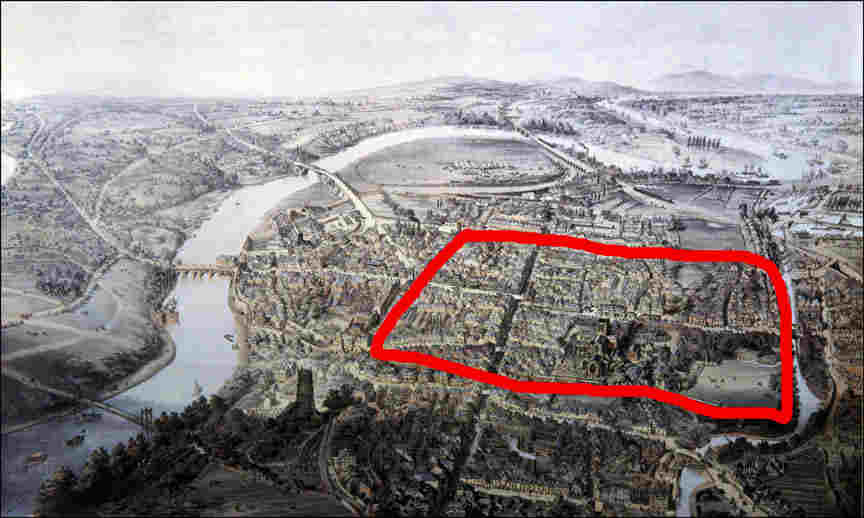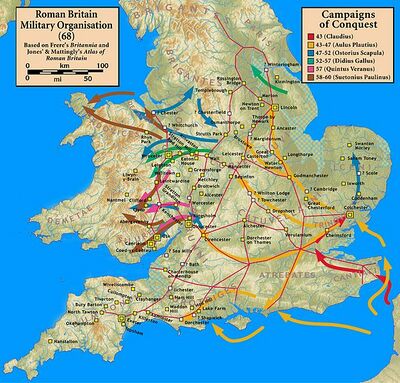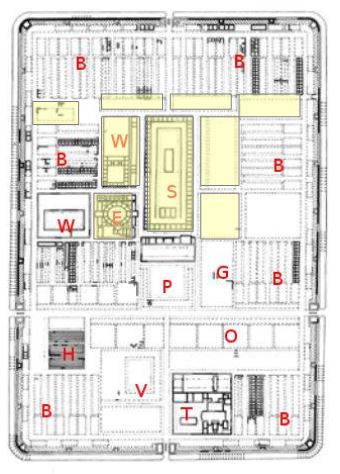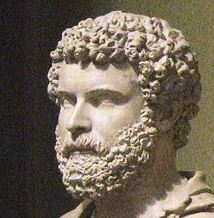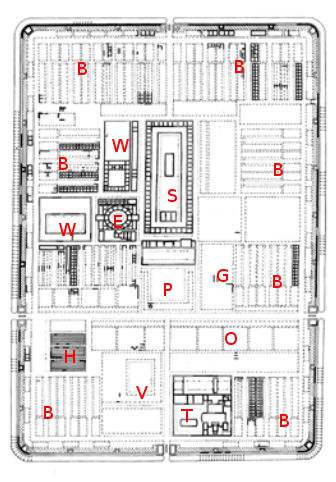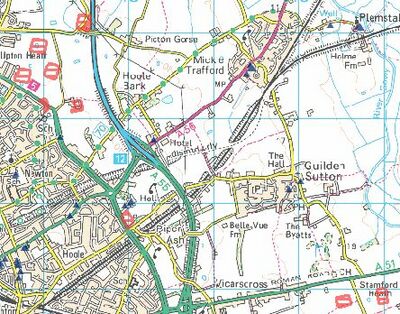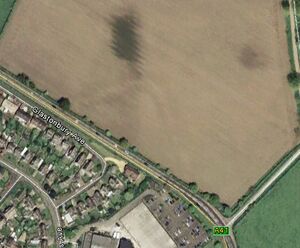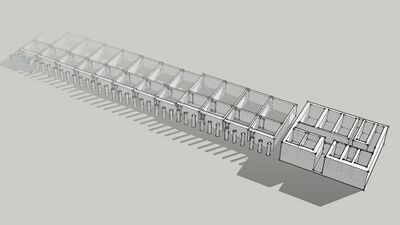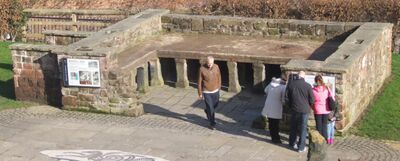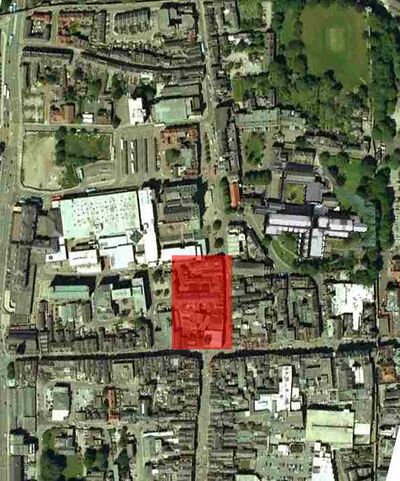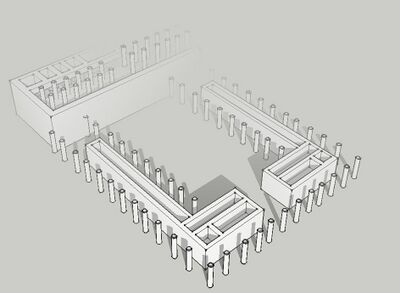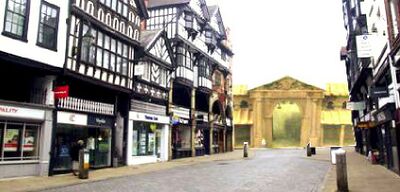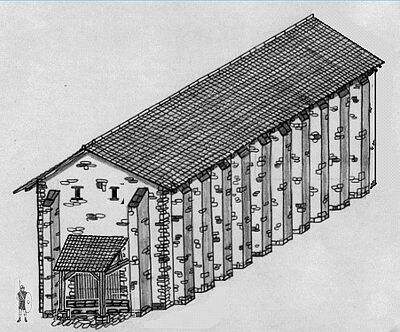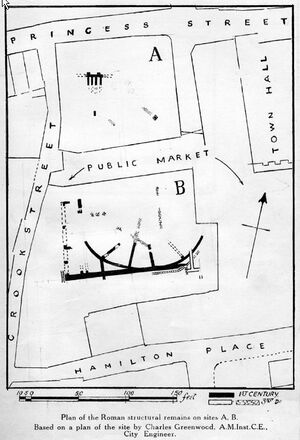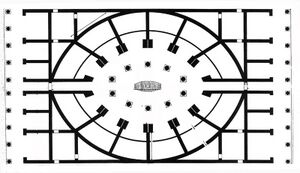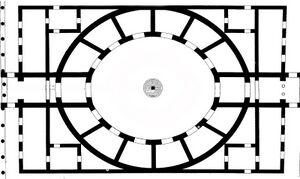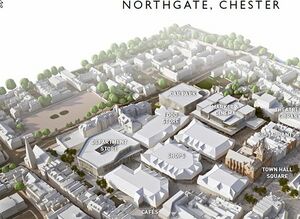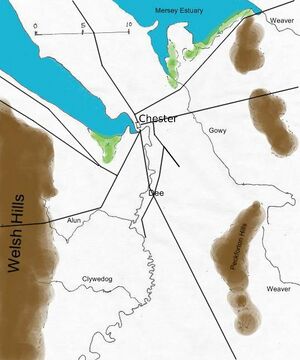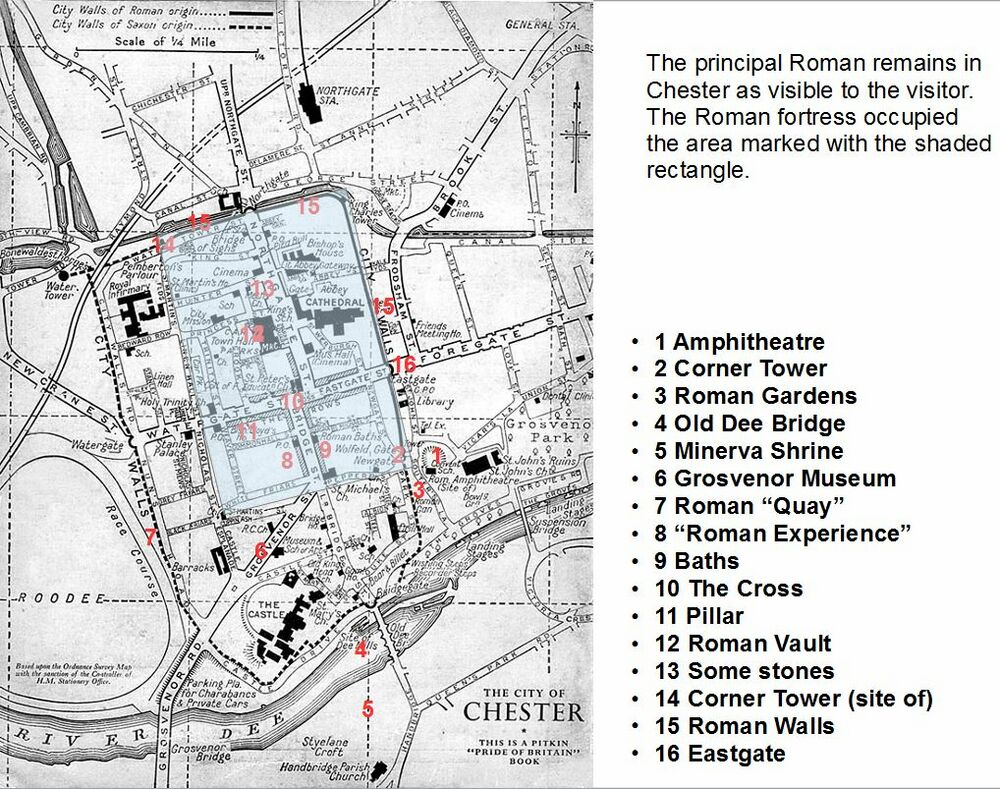Roman Chester
It Isn't Just About The Romans But...
Chester is sometimes described as a "Roman City" still enclosed by original Roman walls. That statement is not exactly true, but parts of it are. Chester was once a major Roman legionary fortress and probably only had a relatively small civilian population (about which very little is known). The City Walls partly follow their Roman course, but the area they enclose was later expanded, and while some Roman parts remain they have been much repaired for reasons that have nothing to do with the Romans. The post-Roman history of Chester is discussed elsewhere on this site, but this article is about Roman Chester and its context. For anyone only interested in the Romans a visit to Chester will not be a disappointment. You can still walk portions of the walls and streets on which the Romans trod. The city is home to the impressive Amphitheatre. The Grosvenor Museum hosts an impressive collection of Roman gravestones. The Minerva Shrine is unique. The history of Chester is "not just about the Romans", but the Roman history is an important part of it.
This is part of a series of articles on the history of Chester through time:
Stuart Chester and the Civil War
Visiting Roman Chester and Roman North Wales
We have a Roman Festival Trail page which documents the location of the principal Roman remains visible to the casual visitor to Chester. Outside of Chester there are many other Roman remains but most of these are often a bit of a "poor show" for the casual visitor, and in some cases sites mentioned by the Romans in their literature still await discovery. The map below shows the sites in the region and a "best guess" at where the Roman Roads may have been. As the routes taken by Road Transport is determined by topography, earlier and later trade and conquest routes would have followed similar courses, and until relatively modern times the rate at which armies moved would be the speed at which they could march, so it is unsuprising that later conquerors of Wales, such at the Normans and Edward I tended to build their castles close to where the Romans had their forts - about a day's march apart. Also many of the Roman sites appear to be associated with later religious sites as travellers between monasteries would use the same routes, the same stopping places (and frequently rob-out the Roman stone to build churches).
The sites marked in red have some obviously visible Roman remains, while those in blue have little to see. Here are some comments on the other sites near Chester:

Caer Gybi
A unique Roman fortress. It is one of Europe's only three-walled Roman forts, the fourth side was protected by the sea and was probably used as a quay. The walls of the fort still stand to an impressive height - 4 metres tall - and are constructed in the distinctly Roman herring-bone style with courses of flat stone cementing the structure. The wall would originally have been topped with a parapet walk. It is thought to date from the 4th Century and was "abandoned" in 393. In the 6th century, the fort was given to Saint Cybi, who used it to build a monastery. The Church of St Cybi still stands on the site today, with a small detached chapel over Cybi's grave. There are the remains of three towers, one the North west, is mostly Roman origin and two others largely later reconstructions. The fort measured 246ft (75m) by 148ft (45m), the walls stood up to 13ft (4m) high and are 5ft (1.5m) thick. There were originally 4 towers, today there are 3, the largest is 26ft (7.9m) tall but most of this is a later rebuild. The walls are believed to have extended down to the sea and a further pair of drum towers. The fort is unique in Britain but follows the pattern of late Roman beachhead forts used to accomodate galleys and scout ships. Similar forts built under Valentinian are known along the Rhine and the Danube.
- "Cybi's Fort" on Cadw;
Viroconium
A Roman town, one corner of which is now occupied by Wroxeter, a small village in Shropshire, about 5 miles (8.0 km) east-south-east of Shrewsbury. At its peak, Viroconium is estimated to have been the 4th-largest Roman settlement in Britain, a civitas with a population of more than 15 000. The settlement probably lasted until the end of the 7th century or the beginning of the 8th. Extensive remains can still be seen. The settlement is entirely of Roman origin, probably beginning as a temporary marching camp established beside the great arterial route of Watling Street around AD 48 and would then have stood on the edge of the Roman Empire, forming part of its frontier with Wales. The discovery, in 1975, of a fortress on the site sheds some light on the likely next phase of the city's development. In AD 58, some ten years after the site had first been settled, the Emperor Nero decided to secure the Imperial boundary by subjugating the adjoining Welsh lands. This was to see the military presence in this key outpost change from a temporary camp-site to a permanent garrison. It is believed that the XIV Legion were the first occupants of this new encampment and were subsequently replaced by the XX Legion from AD 69 - AD 80. The next major stage came once the settlement's role changed from that of a front-line base. With the scaling down of the military presence, the growing town would have passed to the civil authorities and become one of the Coloniae -- a community for Roman Citizens, principally retired servicemen, created to show the benefits of civilization to the native tribes. By this time, Viroconium had already established a sizeable civilian population, largely drawn by the relative safety of the fort and the economic opportunities offered by supplying the needs of the troops stationed there. Declared the capital of the Cornovii Britons and given both its own administration and good measure of local autonomy, the city's development subsequently grew along the typical grid-line pattern characteristic of such tribal centres. The law court, market place and public baths date from this period. The nearest major castle from a later date is that at Shrewsbury, a city built in a naturally defensive loop of the River Severn, some five miles from the Roman city.
- Wroxeter at "Time Travel Britain";
Segontium
A Roman fort on the outskirts of Caernarfon. The fort, which survived until the end of the Roman occupation of Britain, was garrisoned by Roman auxiliaries from present-day Belgium and Germany. Although the A4085 to Beddgelert cuts through the site, and despite the site being plundered to provide stone for Edward I's castle at Caernarfon, most of the fort's foundations are preserved. In Segontium we have the only continuously occupied, long-lived auxiliary fort in Wales, with occupation only terminating circa AD 393/4. There is some evidence that the site served not only as a military base, but also as an administrative focus for the region from the mid-Antonine period to sometime in the mid-third century. There is clear evidence that the initial garrison had been reduced in size by about AD120. A large courtyard house, with its own small bathhouse, was constructed in the mid 2nd century. This impressive building may have been the residence of an important official who was possibly in charge of regional mineral extraction. In the earlier part of the 3rd century the garrison was the First Cohort of Sunici, a 500-strong infantry regiment originally recruited from Germany. The name of the unit appears on an inscription, which records the repair of the fort's aqueduct around AD200. The garrisons of the later 3rd and 4th centuries were much smaller. At this time Segontium's main role was the defence of the north Wales coast against Irish raiders and pirates. Coins found at Segontium point to a continued presence of troops at this key fort until AD394.
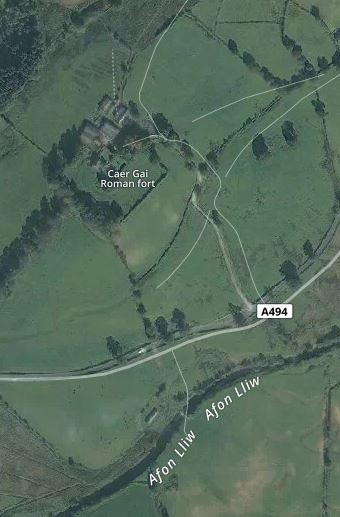
Caer Gai
The fort lies on a low shoulder above the River Dee, with steep slopes on three sides and guards the Roman road from Chester across North Wales to Cardigan Bay. It encloses about 4 acres (1.6 hectares) of land. The remains of the external wall can be seen in places, with five courses of stonework. The mansion of Caer Gai (the present building dates from the 17th century) conceals part of the Roman fort. The fort is laid out on a square plan, about 420 feet on each side. The fort was occupied from around 75 AD until about 130 AD and was defended by earthwork ramparts rising 3 metres high. Inside the earthworks were timber buildings: it seems the Romans never rebuilt the site in stone. Finds on the site have been sparse. In 1865 a number of cremation urns, full of human bone ash, were discovered in a field called Cae Dentir north east of the fort. Two decades later a small timber building thought to be a shrine was excavated in the same spot, and pottery sherds were found, along with a carved stone bearing the inscription 'IVLIVS GAVERONIS F FE MIL CHO I NER'. The stone appears to be a votive panel later re-used as a grave marker. The inscription translates loosely as 'Julius the son of Gavero, ironsmith and soldier of the First Cohort of Nervians'. The 'ironsmith' is probably most closely parallel to what we would call a blacksmith. The Nervian cohort was raised in what is now Belgium. The same unit was later stationed at Netherby in Cumbria. The nearest more recent castle is Carndochan Castle, less than two miles away.
Tomen-y-mur
Located two miles south of Ffestiniog this site commands extensive views. The remains are extensive, with many ancillary features being traceable as eathworks outside the fort: a parade ground, bath house, mansio (Inn), roads, burial mounds, a possible temple and a small military amphitheatre. The most notable feature on the site is a Norman motte in the center of the north-west defences of the fort enclosure. Two Roman forts appear to have been built here, of Flavian and Hadrianic dates, with the latter having stone defences. The forts appear to have been occupied 78-140 AD.
Kanovium
The Roman fort of Kanovium (Caerhun) sat at an important ford on the Conwy river that connected the Roman center at Caernarfon (Segontium) with Chester (Deva). Excavation has revealed two timber periods in the early history of this fort, rebuilding being carried out sometime during Flavian times. The sacellum in the centre of the camp was the first building to be replaced in stone during the reign of Trajan, followed by the rampart-wall in Hadrian’s reign. Hadrianic and Antonine samian ware shows continued occupation through these times, but the well in the principia was filled around AD196/7, which may indicate either destruction or desertion at this time. Occupation at the fort was soon resumed, however, as attested by the building of a new cook-house behind the rampart around 235, and continued occupation throughout the third and fourth centuries is proven by pottery and coins dateable to both these periods. The last coin recovered from the site is one of Gratian (367-383). The nearest major castle is Conwy, at the mouth of the river abut four miles downstream. However in Roman times the lowest practical crossing would have been at Kanovium.
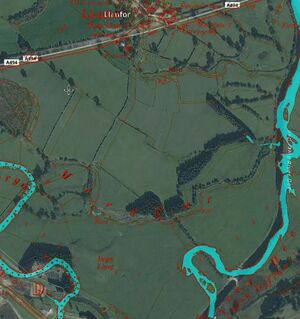
Llanfor
On the River Dee, has very little to see. Only in the mid 70's was the major Roman camp here idenified by "crop marks". The fort is roughly square, with sides running 650 feet along an east-west axis, and 600 feet north to south, enclosing an area of about 9 acres. The site is defended by a rampart and 3 ditches on all sides. The ramparts appear to have been made of simple turf walls. The fort was probably built around 70 AD and was in use for only a short period before it was replaced by a new fort at Caer Gai, 5 miles distant, about 75 AD. It seems that the defences were slighted to make them unusable; the rampart was pushed down to backfill the ditches when the legions left for the newer fort. Later, nearby castles include a possible motte in Llanfor and a motte in Bala, half a mile away.
Pen Llystyn
The fort was probably established in the AD 70’s and then deliberately destroyed by its garrison and abandoned in around AD 90. It is located on the Roman Road from Segontium to Tomen-y-mur (the modern A487). The site was extensively excavated and documented between 1954 and 1962, and the fort is now almost completely removed due to gravel extraction, because it’s now the site of a quarry. In fact the site of the fort was only discovered by gravel digging in 1957. The plan of the fort from a "rescue" dig in 1957-63 suggests that it housed around 960 foot-soldiers. In the garden of the nearby Llystyn Gwyn farm, to the north of the site, a stone was found from the 6th century with Latin and Ogham inscriptions. In Latin the inscription reads ICORI(X) FILIUS / POTENT / INI (Icorix, son of Potentinus). Bilingual inscriptions are common in south west Wales, however this is the only one to have been found in north west Wales.
- Pen Llystyn at Wikipedia;
Brithdir
Earthwork remains of a 2nd century Roman fortlet east of Dolgellau. Archaeologists found evidence of lead smelting and tanning at the site, which was abandoned around AD 145. The outline of the fort can clearly be seen from the ground. The small fort was built at the junction of Roman roads, one of which (the modern A494) led to Caer Gai, and midway between the larger forts at Tomen y Mur and Pennal. The fort occupies the west side of the Wnion valley, and is made up of a level platform with rounded corners, about 54 meteres square. The fort was first discovered from the air, and though no excavations have been carried out within the fort, investigation in the surrounding fields showed that the site was first occupied around AD 74, when a polygonal structure was erected. This first structure was roughly 120m by 100m. Around AD 120 a road was made through the site, and a workhouse and bathhouse built. Cymer Castle and Abbey are about three miles away.
Pennal
The small village of Pennal is located on the banks of the Dyfi, just a few miles west of the market town of Machynlleth. The Roman fort near Pennal is situated along the crest of the ridge running north-east from Cefn-Caer Farm. The fort measures approximately 550 feet from north-east to south-west, by about 425 feet transversely (c.168 x 130 m), and therefore covers an area of around 5 and one-third acres (c.2.17 ha).
- an illustration of the fort;
- Other remains at Pennal - including the later castle;
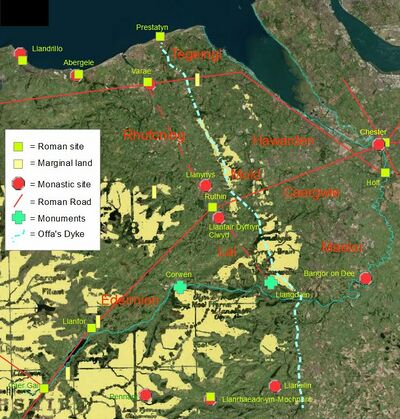
Mediolanum
The town (modern day Whitchurch) was located on a major Roman routeway, the "Via Devana", between Deva Victrix (Chester) and Viroconium Cornoviorum (Wroxeter) - the modern day Eaton Road leaving Chester. Eventually the Via Devana leads to Colonia Victricensis (Colchester). The Romans first built a fort at Whitchurch which has been tentatively suggested as forming part of the border defences established by Ostorius Scapula around AD 52. By about AD 100, however, the army had probably moved on and the surrounding civilian 'vicus' would have taken over the site. In the mid-2nd century, the area was at least partly covered by timber-framed industrial buildings. The town reached the height of its prosperity by the early 3rd century and there was much rebuilding in stone. This continued for the next hundred years. Masonry houses with associated wooden outhouses were most common during this period. Roman artefacts from the site are on display in the Whitchurch Heritage Centre.
Bryn y Gefeiliau
Bryn y Gefeiliau is a Roman fort in the Llugwy Valley. Also known as Caer Llugwy, it was founded around AD 90 to house a cohort of auxiliary soldiers - around 500 men in all. Recent geophysical surveys suggest that, around AD 120, a second, stone-built fort was erected over the eastern defences. It is thought unlikely that the site was occupied much after AD 140 and no evidence of a vicus, or civilian settlement, has ever been found here. Bryn y Gefeiliau means ‘Hill of the Smithies’, and it has been suggested that part of its function might have been to control lead mining in the area. Unfortunately, though the outline is clearly visible on OS maps and aerial photographs there is very little to see on the ground. Most of the stone from the fort was robbed-out for local building projects over the centuries. There are bits and pieces of Roman stones built into many of the nearby farm buildings and field walls.
- Bryn y Gefeiliau on Wikipedia;
Caersws
The Caersws Roman Forts were two forts. The first fort at Caersws was a campaigning camp built in a bend of the River Severn at Llwyn-y-Brain, three quarters of a mile east of the present village. It is large for such a fort and may have been erected in the reign of either Claudius or Nero. About AD 78, the campaigning camp was replaced by a permanent square fort for Roman auxiliary troops as the conquest of Roman Wales was consolidated. It was smaller and built closer to the confluence of the Rivers Carno and Severn on the site of present-day Caersws. A bank and triple ditch enclosed 7.75 acres (3.18 hectares). The headquarters building of the surrounding fort walls were rebuilt in stone around 200. There was a military bath house and a civilian vicus. Occupation lasted into the early 4th century.
- Caersws on Wikipedia;
Forden Gaer
A Roman settlement centred on large earthwork enclosure, the Gaer. Comparison with Leintwardine suggests this was a civil settlement or town, albeit one with military origins. The ploughed-down earthworks of the rectangular, round-cornered, enclosure cover an area of about 200m north-south by 186m and stood up to 2.8m high in 1973. It is speculated that the earliest Roman occupation was a large Flavian fort of about 6.3ha constructed on the line of the road between Caersws and Wroxeter and close to an important fording point on the River Severn. The civil settlement was laid out in the earlier second century and came to be enclosed by a triple ditched enclosure of 3.3ha with north and south facing entrances. This enclosure was reconstructed at least two times, resulting in the present earthworks. It is likely that it represents a westwards expansion of an earlier circuit, as north-south double ditches can be seen crossing at a slight angle on the aerial coverage.
- Forden Gaer at Coflein;
Plas Adda
In 1981 an aerial survey of the Ruthin area discovered the outline of a Roman enclosure near Tyn-y-Wern farm, just south west of Ruthin. The farm site was located on a low rise of gravel beside the River Clwyd, about 650 feet from the route of the Roman road between St Asaph and Caer Gai. The layout was a rough trapezoid, with a rough area of 4.5 acres. The size of the fort suggests that it was built to house a cohort of auxiliary infantry (about 500 men). Still in 1981 an even more exciting discovery was made during construction work for a new hospital; remains of stake holes were found near a pit containing fragments of pottery from the period 70-110 AD. When the new Brynhyfryd Park housing estate was erected in 1988 a large amount of Roman pottery was found, along with post holes, ditches, and a hollow-way track. The pottery spanned a huge time period, from the 1st to the 4th century, though most was from the late 1st and early 2nd century. Four cremation burials were uncovered, and a dozen graves, 6 of which held 2nd-4th century pottery. The accumulated remains led some archaeologists to proclaim the Brynhyfryd Park site an earth and timber fort from the Flavian period, roughly 70-100 AD. The most likely site for a permanent Roman fort is where the castle now stands but later development has obliterated all trace of it.

Prestatyn
Prestatyn lies five miles north of the main east-west Roman Road from the legionary fortress at Deva (Chester) into North Wales. Excavations between 1984–85 at Melyd Avenue, Prestatyn, in advance of proposed housing development, revealed part of a civilian settlement established shortly after AD 70, overlying an earlier Iron Age settlement dating to the 2nd–1st century BC. A bath-house and other buildings were added in the period AD 120–150, and there is evidence of continued occupation until the late 3rd or early 4th century AD. Apart from the stone bath-house all the buildings identified by excavation were of timber.
Roman Cheshire
Apart from the Villa at Eaton near Tarporley it is often said that there is little to be seen of the Roman presence outside of Chester itself. This stone villa is unique in the north-west and was built at the end of the 2nd century on the site of an earlier timber building. It was a winged "corridor" villa with five main rooms and two projecting wings. One of the wings held the bathhouse and many of the other rooms had hypocausts (under floor heating systems). The walls were decorated with wall plaster and there were mortared pebble floors. However, a closer look a Cheshire will reveal more of the Roman presence: one of the most obvious being the courses of some modern roads which still follow Roman routes (see: Road Transport).
What is known about Roman Cheshire is summarised below.
Pulford
There is considerable evidence of Roman occupation at Poulton, on the Welsh border, in the form of building materials (stamped roof-tiles), window glass, as well as pottery (Samian, Black Burnished and Holt Wares), cosmetic items, coins, and brooches. Although these hint at the presence of a structure there is, as yet, no positive identification as to its location, or whether it was a villa, temple or both. A well as being the site of a c.3500-1500 BC timber henge, Poulton was also the location of a short-lived (c. 80 years) 'lost' 12th century Cistercian abbey.
Condate (Northwich)
The first references to Northwich are during Roman times when the town was known as Condate, thought to be a Latinized form of a Brittonic name meaning "Confluence": it lies near the junction of the rivers Dane and Weaver. Halfway between Deva (Chester) and Mancunium (Manchester) would be a good location for an early fort site - which was placed on "Castle Hill" (now built-over), half a mile west of the present town-center. The fort has been excavated from 1983 onwards and shows two periods of military occupation. The first began around AD 70 and the second finished around AD 140. The fort was smaller during its second occupation. Excavations discovered the remains of barrack blocks and courtyard building thought to be a Praetorium, or commandant’s house. The Romans used lead salt pans to extract salt from local brine springs. Salt pans and 1st-century brine kilns have been found around the Roman fort.
- History of Northwich;
- Achaeology Assessment Northwich;
- Northwich at Roman Britain;
Salinae (Middlewich)
Salt extraction was one of the most profitable industries of the Cornovii tribe and was carried out at several sites in Cheshire, notably at Middlewich, known in Roman times as Salinae 'the Salt Pans'. On the west side of King Street, to the north of Middlewich (Salinae) and just to the south of the crossing of the River Dane, geophysical survey and sample excavation in 1993 revealed a camp, almost square in plan, which enclosed an area of approximately 1.2 ha (3.2 acres). In the east and west sides there were gates, marked by a causeway across the ditch at the central point; on the north and south the gates were offset to the east towards the Roman road.
- Salinae at Roman Britain;
Meols
Sea erosion at Meols has revealed much Roman material including walls, coins, brooches, pins, beads, fish-hooks, net-sinkers, spindle whorls and agricultural implements. This may have been a fishing port or simply a trading port.
- Meols at Roman Britain;
Heronbridge
The Roman and later site at Heronbridge stands on the west bank of the River Dee two kilometres south of Chester city centre, between the river and the line of Watling Street (now Eaton Road). Much information has come to light due to the efforts of the Chester Archaeological Society. The history of the site is very complex, with Roman remains overlaid with remnants of burials from the Battle of Chester (see Dark Ages), later Civil War fortifications and various other uses of the site following this. There are some, very few, remains visible on-site.
- Heronbridge at Roman Britain;
Holt
It is thought that the pottery and tile kilns unearthed here represent the main legionary pottery works of Legio XX Valeria Victrix who were housed in the legionary fortress at Deva, about seven miles to the north. The military tilery here produced various wares, such as flat hypocaust tiles to support underfloor heating and box-flue tiles for conducting the central-heating gases in bath-houses, also imbrex and tegula roofing tiles and roof antefixes. Many of these products were stamped LEG XX V V "[Property of] the Twentieth Legion Valeria Victrix", while others also sported the Legion's boar emblem. In the churchyard at Holt is a red sandstone pillar for a sundial mounted on a stepped circular base, and has acircular shaft becoming octagonal above a roll moulding. The octagonal faces are incised "TP WR CW 1766". It has no dial. It has been suggested that it may originally have been part of a Roman column.
- Holt at Roman Britain;
Saltney
Rectangular building with stone foundations were found on the edge of Saltney Marsh to the south-west of Chester (Newstead 1935). This settlement, which flourished in the 2nd and 3rd Centuries. The buildings (now covered by the Lache housing estate) seem to have been poorer quality than those in the canabae (next to the Walls), apparently consisting of stone-founded, rectangular houses with tile roofs, possibly set within ditched enclosures. A wide range of pottery was in use, including Samian and fine wares, and other finds include an intaglio, a shale amulet, quernstones (including one ‘beehive’ type) and iron tools, which possibly indicate an agricultural economy and a small farming settlement supplying Chester.
- pdf mentioning Saltney excavations.

Malpas
In 1812 a bronze, Roman "discharge certificate", dated 103 AD was found near Malpas (at Bickley). This is now in the British Museaum. There is no evidence for Roman settlement in Malpas, but it is known that the Roman Road from Deva (Chester) and Mediolanum (Whitchurch) passes through the village. The "Malpas Hoard" is a group of 35 coins which were struck between 134BC and around AD50. It was discovered during a metal detecting rally near the parish of Malpas on 9 January 2014. There are seven Iron Age British coins in the Malpas Hoard, made between AD20 and AD50. The Roman coins are early examples, struck before the conquest of Britain, and of the type that would have been in circulation when Roman soldiers arrived in Britain in AD43. The latest coin, a denarius of Tiberius (AD14-37) isn't very worn, which suggests that the hoard would have been buried within about ten years of the Roman invasion - some time before the Romans came this far north.
- Malpas Hoard;
- Archaeology Assessment for Malpas;
- Military diploma from the British Museum;
Wilderspool
Large numbers of Roman coins have been turned-up as casual finds over the years at Wilderspool (near Stockton Heath, Warrington), confirming the Roman presence here (Watkin 1886, Kendrick 1872). These antiquarians recorded some 23 coins with various provenances ranging from Republican silver issues to silver & copper issues of Commodus, including 9 of Trajan and 4 of Hadrian both of silver and copper denominations. Many more coins were recovered during extensive excavations conducted by Thomas May between 1895 and 1906. The Roman settlement at Wilderspool, was probably a purely civilian settlement, housing a largely industrial community. It though to have been possibly occupied from the end of the first century (c, 80 AD) to the late third or early fourth century AD. The settlement grew up around the area where the river Mersey was at its lowest allowing the crossing of river by ford. It would also have been the best place for ships to offload cargoes intended locally and is believed to have become a port and an industrial town. 19th century quarrying for sand produced a large amount of Roman finds and the cutting of the Manchester Ship canal in 1887-94 revealed more of the archaeology of this site, establishing that the area was a centre for Roman industrial production of pottery, glass, iron and bronze work.
- Wilderspool on Revealing Cheshire's Past;
- Wilderspool on Roman Britain;
- Achaeologly Assessment for Warrington;
The Roman Invasion
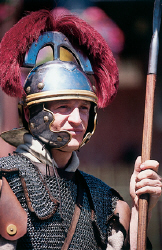
In 69, the "year of four emperors", civil war raged in Rome and weak governors were unable to control the legions in Britain. Venutius of the Brigantes seized his chance, ending up in control of the north of the country. After Vespasian secured the empire, his first two appointments as governor, Quintus Petillius Cerialis and Sextus Julius Frontinus, took on the task of subduing the Brigantes and Silures respectively - the Romans then conquered more of the island, building a fort at Chester on the way. The governor Gnaeus Julius Agricola, with XX Valeria Victrix, defeated the Caledonians in 84 at the Battle of Mons Graupius (somewhere in northern Scotland). Chester was occupied for the next 300 years and may have been the effective capital of Roman Britain. Somewhat surprisingly, the cost in GDP to the Roman Empire of maintaining the Legions was apparently comparable to the percentage of GDP spend by Britain on maintaining the armed forces alone (2-3%), and for that the Roman managed to conquer and hold a quarter of the world's population and provide a fairly effective police force.
Around 384, the usurper Magnus Maximus (he is mentioned on the "Pillar of Eliseg") fought a successful campaign against the Picts and Scots, but his continental exploits required troops from Britain, and it appears that forts at Chester and elsewhere were abandoned at this period. Not all of the troops in Britain may have returned, but by around 396, there were increasing barbarian incursions in Britain.
Early beginnings - the invasion of southern Britain
Most sources state that "Deva" was founded around 74-79 CE during the reign of Vespasian. There has been much discussion as to the origins of the title "victrix" in the name of Legio XX and the fortress. The Roman name of Deva for Chester was pronounced "Deewa" and derives from "goddess". Thus, the Roman fortress was named after the goddess of the River Dee. Today's name Chester derives from the Latin word "castra", which is present, in various forms, in the names of many other towns/cities that were once Roman towns and forts. Examples include: Chichester, Colchester, Lancaster, Doncaster, Gloucester, Leicester, Exeter, Wroxeter.
The Roman invasion of Britain marks the formal end of the British Iron Age, although some believe that the Iron Age still continues (unless recently superseded by the age of the "Bakelite People", or the "Paleosilicic"). By AD 43, the time of the main Roman invasion of Britain, Great Britain had already been the target of planned or actual Roman invasions, starting with Julius Caesar's failed expeditions in 55 and 54 BC. Augustus prepared invasions in 34 BC, 27 BC and 25 BC, but these were called off due to the troops being needed to quell trouble elsewhere in the Roman Empire. Strabo's Geography, written during this period, says that the Client Kingdoms of Britain paid more in customs and duties than could be raised by taxation if the islands were conquered.
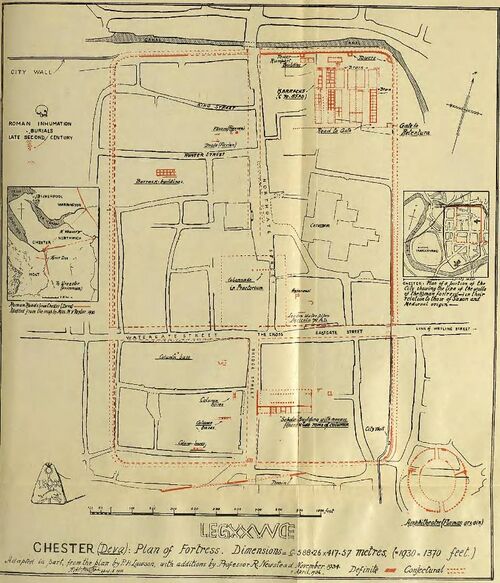
By the 40s AD, however, the political situation within Britain was rapidly changing. The Catuvellauni had displaced the Trinovantes as the most powerful kingdom in south-eastern Britain, taking over the former Trinovantian capital of Camulodunum (Colchester), and were pressing their neighbours the Atrebates, then ruled by the descendants of Julius Caesar's former ally Commius. "Barking mad" Caligula planned a campaign against the British in 40, but its execution was bizarre, he apparently had the troops gather sea shells, referring to them as "plunder from the ocean, due to the Capitol and the Palace" - then he went home.
Finally, in 43, Claudius mounted an invasion under Aulus Plautius, leading four legions, totalling about 20,000 men, plus about the same number of auxiliaries. The legions included Legio II Augusta and Legio XX, both of which were later to be associated with Chester. The II Augusta was commanded by the future emperor Vespasian. The invasion was delayed by a mutiny of the troops, who were eventually persuaded by an imperial freedman to overcome their fear of crossing the Ocean and campaigning beyond the limits of the known world.
British resistance was led by Togodumnus and Caratacus, sons of the late king of the Catuvellauni, Cunobelinus. A substantial British force met the Romans at a river crossing thought to be near Rochester on the River Medway. The battle raged for two days. Hosidius Geta (who probably led the IX Hispana) was almost captured, but recovered and turned the battle so decisively that he was awarded the ornamenta triumphalia. The British were pushed back to the Thames. The Romans pursued them across the river causing them to lose men in the marshes of Essex. Whether the Romans made use of an existing bridge for this purpose or built a temporary one is uncertain. At least one division of auxiliary Batavian troops swam across the river as a separate force. Togodumnus died shortly after the battle on the Thames. Plautius halted and sent word for Claudius to join him for the final push.
Cassius Dio presents this as Plautius needing the emperor's assistance to defeat the resurgent British, who were determined to avenge the recently deceased Togodumnus. However, Claudius was not a man for bloody victory when negotiation would do. Claudius's arch says he received the surrender of eleven kings without any loss, and Suetonius says that Claudius received the surrender of the Britons without battle or bloodshed. It is likely that the Catuvellauni were already as good as beaten, allowing the emperor to appear as conqueror on the final march on Camulodunum. Cassius Dio relates that Claudius brought war elephants and heavy armaments which would have overawed any remaining native resistance. Eleven tribes of South East Britain surrendered to Claudius and the Romans prepared to move further west and north. The Romans established their new capital at Camulodunum and Claudius returned to Rome to celebrate his victory. Caratacus escaped and would continue the resistance further west.
For his part in the conquest, Claudius honoured by being given the surname "Britannicus", which also passed to his sons. Several triumphal arches were errected after his achievement, including one on the Palatine hill. The arch is portrayed on a number of gold and silver coins of Claudius. It features an equestrian statue atop the arch, undoubtedly representing Claudius, between two trophies, a trophy being a pile of captured shields, spears, armour and other spoils of war. On the architrave of the arch is inscribed "DE BRITAN", "DE BRITANN", "DE BRITANNI", or "DE BRITANNIS", depending on the space available.
The next problem faced by the Romans was the Welsh. The Romans may well have wanted to establish a permanent border along the Fosse Way (from Exeter to Lincoln) and exploit the peaceful and productive south of Britain, there was still British resistance to Rome from Wales and the North. Late in 47 the new governor of Britain, Ostorius Scapula, began a campaign against the tribes of modern day Wales, and the Cheshire Gap. The Silures of south east Wales caused considerable problems to Ostorius and fiercely defended the Welsh border country. Caratacus himself was defeated in one encounter and fled to the Roman client tribe of the Brigantes who occupied the Pennines. Their queen, Cartimandua was unable or unwilling to protect him however given her own truce with the Romans and handed him over to the invaders in chains. In 52 C.E. Ostorius died and was replaced by Aulus Didius Gallus who brought the Welsh borders under control but did not move further north or west, probably because Claudius was keen to avoid what he considered a difficult and drawn-out war for little material gain in the mountainous terrain of upland Britain.
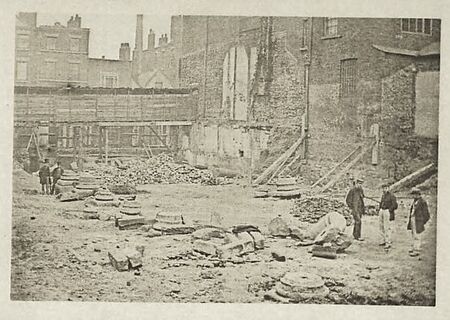
As for Caratacus, he was taken to Rome to be killed after a triumphal parade. However, he so impressed the Romans with his speech (as recorded by Tacitus) that he was freed and lived out his life in Rome:
- If the degree of my nobility and fortune had been matched by moderation in success, I would have come to this City as a friend rather than a captive, nor would you have disdained to receive with a treaty of peace one sprung from brilliant ancestors and commanding a great many nations. But my present lot, disfiguring as it is for me, is magnificent for you. I had horses, men, arms, and wealth: what wonder if I was unwilling to lose them? If you wish to command everyone, does it really follow that everyone should accept your slavery? If I were now being handed over as one who had surrendered immediately, neither my fortune nor your glory would have achieved brilliance. It is also true that in my case any reprisal will be followed by oblivion. On the other hand, if you preserve me safe and sound, I shall be an eternal example of your clemency.
Rome moves north
When Nero (another lunatic) became emperor in AD 54, he seems to have decided to continue the invasion and appointed Quintus Veranius as governor, a man experienced in dealing with the troublesome hill tribes of Asia Minor. He was dead within a year, and according to Tacitus:
- "... Veranius, after having ravaged the Silures in some trifling raids, was prevented by death from extending the war. While he lived, he had a great name for manly independence, though, in his will's final words, he betrayed a flatterer's weakness; for, after heaping adulation on Nero, he added that he should have conquered the province for him, had he lived for the next two years."
Veranius and his successor Gaius Suetonius Paulinus mounted a successful campaign across Wales, famously destroying the druidical centre at Mona or Anglesey in AD 60. Final occupation of Wales was postponed however when the rebellion of Boudica forced the Romans to return to the south east. Suetonius defeated Boudica, reinforced his army with legionaries and auxiliaries from Germania and conducted punitive operations against any remaining pockets of resistance, but this proved counterproductive. The new procurator, Gaius Julius Alpinus Classicianus, expressed concern to the Emperor Nero that Suetonius's activities would only lead to continued hostilities. An inquiry was set up under Nero's freedman, Polyclitus, and an excuse, that Suetonius had lost some ships, was found to relieve him of his command (and governorship of Britain). He was replaced by the more conciliatory Publius Petronius Turpilianus.
Following the suppression of Boudicca, a number of new Roman governors continued the conquest by edging north. Quintus Petillius Cerialis took his legions from Lincoln as far as York and defeated Venutius near Stanwick around 69 AD. This resulted in the already Romanised Brigantes and Parisii tribes being further assimilated into the empire proper.
Oman (History of England, Methuen, 1910) gives the year c57AD as the date that either Aulus Didius Gallus or Suetonius moved the headquarters of one or both of his legions from Wroxeter to Deva, and built a flotilla of flat-bottomed boats on the Dee so that in 60 A.D. he could invade North Wales. As Gallus died in 57 it was probably the latter who started and completed the invasion. However, most writers have Chester's permanent Roman foundation a little later, around 74 AD. As there Romans had been campaigning in North Wales for some time, they may well have visited the locale well before this and even established a semi-permanent "marching camp" at Chester.
In 69 the Romans overthrew the Brigantes. This tribe was a Roman ally ruled by Cartimandua and her consort, Venutius. Cartimandua had been responsible for handing over resistance leader Caratacus to the Romans in 51 AD. Shortly afterwards, she divorced Venutius who revolted but was driven off by Roman arms. But in 69 AD, with the Romans in the midst of civil war, Venutius staged a second revolt and successfully overthrew Cartimandua, who fled to the Romans. According to one scrap of fragmentary evidence she may have lived out her days in Chester. The collapse of the treaty relationship with the Brigantes was an important turning point in Roman history in Britain. The Romans could have reinstated their ally Cartamandua but instead they chose to annex Brigantia and conquer Wales. Having commanded Legio II Augusta back in 43 C.E., under the emperor Claudius, the eventual ruler after the civil war, Vespasian, could well understand how a large-scale conquest in Britain could bolster his reputation back in Rome and help secure his position as emperor.
It is possible that there was already a settlement on the site before the Romans arrived, or at least a "campsite" near the Gloverstone. Some early historical speculation is found in Samuel Lewis's 1848 Topographical Dictionary of England which includes the following information for Chester:
- The origin of this ancient city has been ascribed to the Cornavii, a British tribe who, at the time of the Roman invasion, inhabited that part of the island which now includes the counties of Chester, Salop, Stafford, Warwick, and Worcester; and its British name Caer Leon Vawr, "city of Leon the Great," has been referred to Leon, son of Brût Darian Là, eighth king of Britain.
There may be some confusion here with Caerleon in south Wales. Caerleon is also a site of considerable archaeological importance, with a Roman legionary fortress (it was the headquarters for Legio II Augusta from about 75 to 300 AD) and an Iron Age hill fort. The name Caerleon is derived from the Welsh for "fortress of the legion" (compare with the Anglo-Saxon name for Chester - Legercyestre). "Brût Darian Là" (Welsh: Bryttys darian las) appears to be a reference to Brutus Greenshield one of the legendary kings mentioned by the notoriously inaccurate Geoffrey of Monmouth's 1136 pseudohistorical (i.e. mostly "made up") Historia Regum Britanniae ("the History of the Kings of Britain"). The "Leon" in question may be Liel after whom Carlisle (another Roman fort) may or may not be named.
Raphael Hollinshead tells a similar story, including mention of a specific governor of Britain, P. Ostorius Scapula (who was governor of Britain from AD47-52):
- Carleil builded. Chester repaired. Leill the sonne of Brute Greeneshield, began to reigne in the yeare of the world 3021, the same time that Asa was reigning in Iuda, and Ambri in Israell. He built the citie now called Carleil, which then after his owne name was called Caerleil, that is, Leill his citie, or the citie of Leill. He repaired also (as Henrie Bradshaw saith) the citie of Caerleon now called Chester, which (as in the same Bradshaw appeareth) was built before Brutus entrie into this land by a giant named Leon Gauer. But what authoritie he had to auouch this, it may be doubted, for Ranulfe Higden in his woorke intituled "Polychronicon," saith in plaine wordes, that it is vnknowen who was the first founder of Chester, but that it tooke the name of the soiourning there of some Romaine legions, by whome also it is not vnlike that it might be first built by P. Ostorius Scapula, who as we find, after he had subdued Caratacus king of the Ordouices that inhabited the countries now called Lancashire, Cheshire, and Salopshire, built in those parts, and among the Silures, certeine places of defense, for the better harbrough of his men of warre, and kéeping downe of such Britaines as were still readie to moue rebellion.
Ptolemy's 2nd century Geographia has a passing mention (text) of the two cities of the Cornovii as:
- ..From these toward the east are the Cornavi, among whom are the towns: Deva, Legio XX Victrix 17°30 56°45 and Viroconium 16°45 55°45
"Deva Victrix" is Chester, and "Viroconium" is Wroxeter. The later had become the capital of the Cornovii under Roman rule.
Vespasian
As noted above Vespasian was the victor in the Roman Civil wars of 68-70 AD. These Civil Wars would have led to a lull in the Roman war with the Welsh. With the intent of extending the boundaries of the Roman Empire Vespasian sent Sextus Julius Frontinus into Roman Britain in 74 AD to succeed Cerialis as governor. He subdued the Silures and other "hostile" tribes of Wales, establishing a new base at Caerleon for Legio II Augusta and a network of smaller forts fifteen to twenty kilometres apart for his auxiliary units. During his tenure, he probably established the fort at Pumsaint in west Wales, largely to exploit the gold deposits at Dolaucothi. He retired in 78 AD, and later he was appointed water commissioner in Rome. The new governor was the famous Gnaeus Julius Agricola. He finished off the Ordovices in North Wales and then took his troops north along the Pennines, building roads as he went.
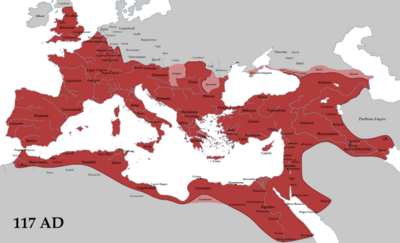
Raphael Hollinshead gets the story a a little confused and has the Romans responsible for the undercrofts on the Rows:
- There be some led by coniecture grounded vpon good aduised considerations, that suppose this Ostorius Scapula began to build the citie of Chester after the ouerthrow of Caratacus: for in those parties he fortified sundrie holds, and placed a number of old souldiers either there in that selfe place, or in some other néere therevnto by waie of a colonie. And for somuch (saie they) as we read of none other of anie name thereabouts, it is to be thought that he planted the same in Chester, where his successors did afterwards vse to harbour their legions for the winter season, and in time of rest from iournies which they haue to make against their common enimies. In déed it is a common opinion among the people there vnto this daie, that the Romans built those vaults or tauerns (which in that citie are vnder the ground) with some part of the castell. And verelie as Ranulfe Higden saith, a man that shall view and well consider those buildings, maie thinke the same to be the woorke of Romans rather than of anie other people. That the Romane legions did make their abode there, no man séene in antiquities can doubt thereof, for the ancient name Caer leon ardour deuy, that is, The citie of legions vpon the water of Dée, proueth it sufficientlie enough.

The precise date at which the Romans began construction at Chester has been the subject of much debate. According to one version, sometime around 74 CE, the then governor of Roman Britain, Sextus Julius Frontinus constructed an "auxiliary fort" at Deva Victrix (Chester). The placement of this fort (at the lowest ford of the Dee) appears to have been a strategic move by Frontinus with the intent of both blocking the route of any routed British trying to escape to the north, and to guard against help arriving from the Brigantes and other northern tribes. Frontinus was a noted engineer as well as being a governor, and author of De aquis urbis Romae, a history and description of the water supply of Rome. It is not known whether he was involved in providing Chester's Water Supply from the springs at Boughton to the Roman fort, but is is known that at this time lead (such as is used for plumbing) was traded with the Deceangli of north Wales. The lead was probably mined at Pentre
- In June 1885 (at the Roodee) a lead 'pig' was found inscribed IMP•VESP•AVGV•T•IMP•III: the word DECEANGI appears on the side (this has been dated: AD74).
- In 1838 (1¼ miles east of Chester's Eastgate) another 'pig' was found with the inscription; IMP•VESP•V•T•IMP•III•COS, and again, on the side; DECEANGI (again dated: AD74).
Frontius is famed for some few of his quotes, although he did provide some useful advice for those seeking to employ a plumber:
- "No greater care is required upon any works than upon such as are to withstand the action of water; for this reason, all parts of the work need to be done exactly according to the rules of the art which all workmen know, but few observe."
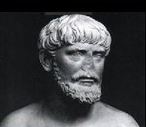
Sextus Julius Frontinus was succeeded as governor (in AD78) by Gnaeus Julius Agricola a Roman general responsible for much of the Roman conquest of Britain. His biography, the well known De vita et moribus Iulii Agricolae (The Life and Character of Julius Agricola), was the first published work of his son-in-law, the historian Tacitus (and says nothing at all about Chester). By AD79, the fort had developed into the extensive base of Legio II Adiutrix (Pia Fidelis). There is another naval link here as the Second Legion were initially raised by Vespasian from the marines (Classis Ravennatis) of the Adriatic fleet. There is no real agreement on the size of the roman fleet which might have been associated with Chester - however it may have been the embarkation point for an attempted invasion of Ireland (see below). There is also no real agreement about what is often called the "massive Roman harbour" and pictured to be the size of the modern Roodee. The nautical character of the city, and the need for combined land and sea operations was probably one reason why the "marine-based" Legio II Adiutrix Pia Fidelis was placed here rather than moving the Legio XX from its base 40 miles away at Wroxeter, where it had take over from Legio XIV Gemina c.65. Another reason for putting Legio II in Chester was that it was the most loyal legion to Vespasian and his Flavian dynasty. In 87, Legio II was recalled to the continent to participate in the Dacian wars of emperor Domitian last of the Flavian dynasty.
Further lead piping can be seen in the Grosvenor Museum which bears the name of Gnaeus Julius Agricola in the following form:
- IMP•VESP•VIIII•T•IMP•VII•COS•CN•IVLIO•AGRICOLA•LEG•AVG•PR•PR
- (Imperator Vespasian nine times and Imperator Titus seven times consul. For Gnaeus Julius Agricola, pro-praetorian legate of the emperor)
Lead pipes had names on them because (according to Sextus Julius Frontinus) in Roman times it was not uncommon to fit a larger diameter pipe and steal extra water from the local aqueduct!
The earlier lead pigs have been used to argue that they were supplies provided for the construction of the city, and there is a fragmentary inscription from the baths which show that the baths were in operation in 79. It is known that the baths were not (quite) the first thing built in a Roman city so it appears that a date around AD 74 is probably correct.
In the year 84,the governor of Britain (and Chester resident) Gnaeus Julius Agricola, with the help of Legio XX Valeria Victrix, defeated the Caledonians in 84 at the Battle of Mons Graupius (somewhere in Scotland). Before the battle Calgacus (the Cadedonian leader) supposedly makes his much quoted "Ubi solitudinem faciunt, pacem appellant" ("you make a wasteland and you call it peace") speech. The following year Agricola was recalled from Britain, and in 87 Legio II Adiutrix was recalled from Chester to the continent to participate in the Dacian wars of emperor Domitian. In 88 The Roman legion XX Valeria Victrix returned to Chester. 93; Agricola died on his family estates in Gallia Narbonensis aged fifty-three. Rumours circulated attributing the death to a poison administered by the Emperor Domitian, but no positive evidence for this was ever produced. Agricola's successors are not named in any surviving source, but it seems they were unable or unwilling to further subdue the far north. The fortress at Inchtuthil was dismantled before its completion and the other fortifications of the Gask Ridge in Perthshire, erected to consolidate the Roman presence in Scotland in the aftermath of Mons Graupius, were abandoned within the space of a few years. It is equally likely that the costs of a drawn-out war outweighed any economic or political benefit and it was more profitable to leave the Caledonians alone. The following century of the "five good emperors" brought previously unknown prosperity to Chester and its hinterland.
There appear to be few, in any, of the large towns and villas in Roman Cheshire which characterise the civilian south of England: The villa at Eaton by Tarporley is so far the only known villa in the North West. By the end of the 2nd Century Cheshire was provided with a regular road network and roads led from Chester into North and mid-Wales. Another road led into the Wirral, probably to Meols and two further routes led northwards across the River Weaver - one to an industrial site (with glassmaking, metalwork, and ceramics) at Wilderspool by the Mersey and a second via Northwich and Manchester to York. Roman roads also linked Wroxeter and Leicester via Whitchurch, Chester, Middlewich and Northwich. While "Romanisation" continued the nearest large civilian centers remained to the south at Wroxeter and towards Lincoln and Leicester. There were few, if any, of the public Forum-basilica or temple developments seen elsewhere and most of Cheshire's towships were "ribbon developments" along roads, mostly of wooden buildings. Chester was foremost a military base and not a fully developed urban center.
Chronology of Roman Chester

Legio secunda adiutrix ("Rescuer Second Legion"), was a legion of the Imperial Roman army founded in AD 70 by the emperor Vespasian (r. 69-79), originally composed of Roman navy marines of the classis Ravennatis (the navy based at Ravenna on the Adriatic), the first assignment of II Adiutrix was in Germania Inferior, where the Batavian rebellion was at its peak. After the defeat of the rebels, II Adiutrix followed general Quintus Petillius Cerialis to Britain to deal with another rebellion led by Venutius. During the next years, the legion was to stay in the British Islands to subdue the tribes of Scotland and Wales, with their base camp at Chester.
c74-90 - Founding the Fortress
Taking 74 AD as the first establishment of a permanent encampment at Chester, there was an initial flurry of activity. Lead ingots have been found dated 74 AD and lead waterpipes dated 79 AD have been found underground in association with the Eliptical Building. The baths seem to have been in use by 79 AD at the latest. Chester (planned as the largest legionary fortress in Britain) was well placed to be the residence of the Governor of the province, having the best port on the west coast and being equidistant from the other major legionary forts at Caerleon and York. several buildings in Chester were possibly added to the normal fortress plan to make it larger than other major legionary fortresses. These include the large building behind the Principia: the courtyard of the large building forms the Town Hall square, the mysterious "Eliptical Building" and some accomodation for "high status" individuals near the site of the Odeon. In addition, the hospital, baths and amphitheater seem larger than would be normally present at a fortress.
However, II Adiutrix would not enjoy their new and presumably quite peaceful fortress for long. In 87 Legio II was recalled from Chester to the continent to participate in the Dacian wars of emperor Domitian. In 88 The Roman Legio XX was relocated, eventually to Chester, from a campaign in what is now Scotland.
c90-120 - From Earth Ramparts to Stone
By c. 90 the Second Legion had no further need of its base at Chester and the depot's future had to be decided. It was quickly realized that, since much of Brigantia was controlled by the army, and Wales had been subjugated, Chester was more usefully placed than Wroxeter, which was effectively landlocked. Accordingly, the legionary depot at Wroxeter was abandoned c. 90, and the Twentieth Legion, Valeria Victrix, established itself instead at Chester, possibly after a short stay at Gloucester. Legio vigesima Valeria victrix ("Valerius' Victorious Twentieth Legion") was a legion of the Imperial Roman army. It was probably founded shortly after 31 BC by the emperor Augustus. It served in Hispania, Illyricum, and Germania before participating in the invasion of Britannia in 43 AD. It remained active in Britain until at least the beginning of the 4th century.
It appears that the first thing that the XXth legion did was rebuild the existing timber barracks, again in timber. These were eventually replaced by stone buildings before 120. At Abbey Green, a new timber-lined main sewage culvert was inserted alongside the Via Sagularis (the road running round the depot inside the defences) and new timber-framed cookhouses and mess huts were inserted alongside the ramparts. By the beginning of the second century rebuilding of the fortress defences in stone appears also to have been completed. This was the time of the Roman Empires greatest extent.
Attracted to Chester by the chance of a living from the large number of well-paid legionaries were local tribesmen, traders of all kinds from near and far, an army of servants and labourers (both slave and free), and officials employed to run the extramural posting houses, harbour facilities, and other official establishments. There were, too, retired soldiers, some probably from Wroxeter, who preferred to live close to their former comrades-in-arms in a lifestyle which retained a military flavour. Many had wives and families. Thus, quite quickly, a sizeable settlement, known as the canabae, grew up outside the walls of the fortress. It remained under direct military supervision, unlike the nearby independent and very large civil settlement at Heronbridge.
c120-210 - Neglect and Decay
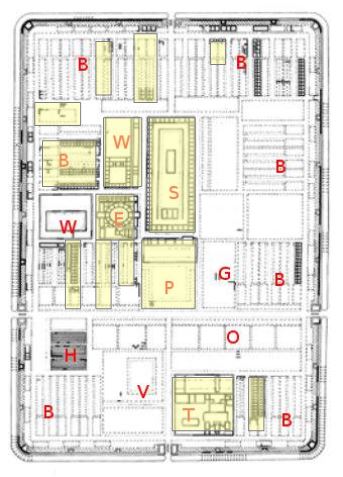
In the "canabae" (the extramural civilian settlement) the rebuilding programme seems scarcely to have begun by the 120s. One of the earliest extramural buildings reconstructed in stone was the Amphitheatre, the various official functions of which presumably demanded priority. On a much grander scale than its predecessor, with seating for at least 7,000 spectators, more than the full strength of the legion, it reflected the expansion of the canabae and perhaps also the requirements of an increasing population, both military and civilian, for entertainments.
In 122AD construction of Hadrian's Wall started and the Legio XX (or at least large parts of it) moved north again. During the following years not only did building work at Chester almost cease, but significant areas within the Roman fortress were abandonned to the point of dereliction, stones were stripped from pavements for re-use and some area's even used as rubbish-tips. Barracks which had not yet been rebuilt in stone were either demolished, or allowed to collapse. One was abandonned half-built, another used for cremation burials. The Large Building accumulated a foot of soil on its floor (in which at least one burial occurred), and the Principia appears to have been neglected. In fact this was a time of considerable unrest in the province of Britannia and the lack of discipline among the troops may have contributed to the dereliction and decay at Chester.
From the barracks which had not fallen into disuse during this period it is possible to estimate that only a small part of the XXth Legion remained in Chester. At this time the fortress at Chester was probably used as a storage and supply station. Changes in the character of occupation after c. 130 may be explained by an intention, perhaps implied in an incomplete inscription found reused behind the headquarters, to demilitarize the site and establish an independent civilian settlement.
In 163 the order is given to abandon the Antonine Wall and for Roman troops to withdraw to Hadrian's Wall. Although the reasons are unclear, it is probable an uprising by the Brigantes forced the retreat.
In 175, a large force of Sarmatian (Iranian) cavalry, consisting of 5,500 men, arrived in Britannia, probably to reinforce troops fighting unrecorded uprisings - or possibly as a highly mobile force to deal with the stirrings of revolt amongst the troops. In 180, Hadrian's Wall was breached by the Picts and the commanding officer or governor was killed there in what Cassius Dio described as the most serious war of the reign of Emperor Commodus. Ulpius Marcellus was sent as replacement governor and by 184 he had won a new peace, only to be faced with a mutiny from his own troops, who tried to elect the legate Priscus as usurper governor; he refused, but Marcellus was lucky to leave the province alive. Back in Rome, commemorative coins were issued and Commodus assumed the title of Britannicus for his "victory". The Roman army in Britannia continued its insubordination: they sent a delegation of 1,500 to Rome (they had been drafted to Italy to suppress brigands) to demand the execution of Tigidius Perennis, a Praetorian prefect who they felt had earlier wronged them by posting lowly equites to legate ranks in Britannia. Commodus met the party outside Rome and agreed to have Perennis killed (Herodian reports that Perennis was also implicated in a plot against Commodus), but this only made the troops from Britannia feel more secure in their mutiny. The future emperor Pertinax was sent to Britannia to quell the mutiny and was initially successful in regaining control, until a riot broke out among the troops in which Pertinax was attacked and left for dead (he survived and asked to be recalled the Rome).
Commodus, who like some other Roman Emperors was barking-mad, gained the hatred of many military officials in Rome for his "Hercules" persona in the arena. Often, wounded soldiers and amputees would be placed in the arena for Commodus (dressed as a gladiator) to slay with a sword. After he changed the name of Rome to reflect his own greatness, had various statues re-modelled in his likeness (with outrageous claims of his fighting prowess added) and started to charge the Romans a million a time for his "gladitorial" appearances. It was decided he had to go, and he was assassinated at the end of 192.
The death of Commodus (31 December 192 AD) triggered events which led to civil war. Following the short reign of Pertinax (the first three months of 193), several rivals for the emperorship emerged, including Septimius Severus and Clodius Albinus. The latter was the new governor of Britannia, and had seemingly won the natives over after their earlier rebellions; he also controlled the three legions in Britannia, making him a potentially significant claimant to the role of Emperor. His sometime rival Severus promised him the title of Caesar in return for Albinus's support against Pescennius Niger in the east. Once Niger was dealt with, Severus turned on his ally in Britannia — although Albinus had almost certainly worked-out that he would be the next target and he was already preparing for war. Albinus crossed to Gaul (France) in 195, where the provinces were also sympathetic to him, and set up at Lugdunum. Severus arrived in February 196, and the ensuing battle was decisive. Albinus came close to victory, Severus's reinforcements won the day, and the British governor committed suicide.
Albinus had demonstrated the major problem posed by Roman Britain: in order to maintain security, the island province required the presence of three legions; but command of these forces provided an ideal power base for ambitious rivals. Deploying those legions elsewhere, however, would strip the island of its garrison, leaving the province defenceless against uprisings by the native Celtic tribes and against invasion by the Picts and Scots. Severus had a simple solution - exterminate the Caledonians.
c210-260 - Restoration
In 208 Severus traveled to Britain with the intention of conquering Caledonia. Cassius Dio's account of the invasion reads:
- "Severus, accordingly, desiring to subjugate the whole of it, invaded Caledonia. But as he advanced through the country he experienced countless hardships in cutting down the forests, levelling the heights, filling up the swamps, and bridging the rivers; but he fought no battle and beheld no enemy in battle array. The enemy purposely put sheep and cattle in front of the soldiers for them to seize, in order that they might be lured on still further until they were worn out; for in fact the water caused great suffering to the Romans, and when they became scattered, they would be attacked. Then, unable to walk, they would be slain by their own men, in order to avoid capture, so that a full fifty thousand died. But Severus did not desist until he approached the extremity of the island. Here he observed most accurately the variation of the sun's motion and the length of the days and the nights in summer and winter respectively. Having thus been conveyed through practically the whole of the hostile country (for he actually was conveyed in a covered litter most of the way, on account of his infirmity), he returned to the friendly portion, after he had forced the Britons to come to terms, on the condition that they should abandon a large part of their territory."
Fortunately for the Caledonians, Severus fell ill during his attempted extermination (hence the litter) and died in early 211 at Eboracum (York). As one of his last acts, Severus tried to solve the problem of powerful and rebellious governors in Britain by dividing the province into Britannia Superior and Britannia Inferior. This kept the potential for rebellion in check for almost a century - a period known as the "Long Peace".
Following the cessation of warfare it seems that the 20th Legion returned to Chester and began rebuilding the (by now quite decrepit) fortress. The entire street and sewer system was repaired, with the new, much enlarged Roman sewers surviving until relatively recent times and giving rise to many of the legends about underground tunnels beneath the City. The barracks were repaired as stone or part stone structures and the Centurion's quarters gained underfloor heating. Tile manufacture at nearby Holt had ceased but gradually Welsh slate came to be used for roofing. The Principia was rebuilt from the foundations up, indicating that this important ceremonial building had fallen into serious disrepair in the previous century. The last actual evidence of Legio XX being at Chester comes from around 250 AD. In 255, a subunit of the XXth was fighting in Germania and, after its victory, sent to the Danube. The legion was still active during the reign of the usurpers Carausius and Allectus (286-293 and 293-296), but is not mentioned in the fourth century. Perhaps it was disbanded when the Roman emperor Constantius I Chlorus reconquered Britain.
c260-350 - A Tranquil Backwater

During the latter half of the 3rd century, the Roman Empire faced a crisis. Internally weakened by civil wars, the violent succession of brief emperors, and secession in the provinces, it faced a new wave of attacks by "barbarian" tribes. Most of Britain had been a Roman province since the mid-1st century, mostly (but not always) protected from raids in the north by the Hadrianic and Antonine Walls, and by the Classis Britannica patrolling the English Channel. As frontiers came under increasing external pressure, a "fortification" program was undertaken throughout the Empire to protect cities and other strategically important locations. At this time the forts of the Saxon Shore were built. As early as the 230s, under Severus Alexander, units were being withdrawn from the north and garrisoned at locations in the south.
By 261 troops in Britannia had joined the revolt of Postumus as part of his Gallic Empire. In 274 the Gallic Empire was re-absorbed into the main Roman Empire. However, in 287 the admiral of the Roman Channel fleet, Carausius, declared himself Emperor of Britain and Northern Gaul and started minting his own coinage. Carausius was assassinated by his treasurer, Allectus, in 293 who quickly started work on his palace in London to solidify his claim to authority. New forts were constructed at Brancaster, Caister-on-Sea and Reculver. Dover was already fortified since the early 2nd century. By the 290s, the full chain of forts was completed. They would buy the Romano-British another 100 years. The Roman Empire recaptures Britannia and Allectus was killed in battle near Silchester in 296. Britain was then split up into four provinces.
There is some evidence for major repair work at Chester around 300, especially to the walls. The later Emperor Constantine was in Britain campaigning with his father Constantius Chlorus who died on 25 July 306, at York, leading to Constantine being proclaimed emperor. He was later known as "Constantine the Great". After his promotion to emperor, Constantine remained in Britain for a while, and secured his control in the northwestern dioceses. He completed the reconstruction of military bases begun under his father's rule, and ordered the repair of the region's roadways. It is not known whether either the older or younger Constantine ever visited Chester, but given their importance in the north of Britannia it is probable that they did - evidence being provided by Roman milestones found in North Wales.
Following yet another revolt (that of Magnentius), Paulus "Catena" was dispatched to Roman Britain in 353 by the paranoid Constantius II to exact savage reprisals against supporters of Magnentius in the army garrisons of Britain. Paulus was also probably a paranoid psychopath. Once he arrived, he widened his remit and began arresting other figures, often on apparently trumped-up charges and without evidence. So harsh were his measures that he earned the nickname Catena meaning 'The Chain'.
c350-400 - Rome fades from Chester (for further detail see: Dark Ages)
By the middle of the fourth century Britain was an integral part of the Roman Empire. Although it was often threatened it was strongly defended and may well have been as populous in 300 as it would be in 1500. From the number of coins found thee economy was active. Villas built at this time show sighns of considerable prosperity and a surplus which could be used to adorn them with mosaics. The first Bishops in Britain were active by 314 and it is telling that the province was well enough connected that a religion with its roots in the middle-east could establish itself here, even in levels of society which included those able to decorate villas with Christian symbolism. Many of these weatlthy people would have been British.
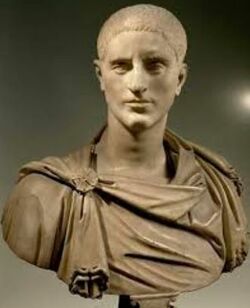
In the winter of 367, as part of the "Great Conspiracy" the Roman garrison on Hadrian's Wall rebelled, and allowed Picts from Caledonia to enter Britannia. Simultaneously co-ordinated and pre-arranged waves of, Attacotti, Scotti from Hibernia, and Saxons from Germania, landed on the island's mid-western and south-eastern borders, respectively. These groups managed to overwhelm the entire western and northern areas of Britannia. The cities were sacked and some civilian Romano-British murdered, raped, or enslaved. Marcellinus records that Nectaridus, the "Count of the Saxon Shore" was killed, and that the "Dux Britanniarum", Fullofaudes was either besieged or captured.
In the spring of 368, a relief force commanded by the elderly Flavius Theodosius arrived in Britannia from Gaul. He brought with him four units of comitatenses, (Batavii (Dutch), Heruli (Germans), Jovii and Victores) as well as his son, the later Emperor Theodosius I (379-395). Order was restored, but only after yet another rebel, Valentinus and his co-conspirators for yet another revolt were handed over to the new "Dux Britanniarum", Dulcitius, for execution (see Ammianus; Book 28 Chapter III). Theodosius – unlike Paulus Catena – made it clear that he did not want to indulge in a wholesale purge:
- de coniuratibus quaestionibus agitari prohibuit, ne formidine sparsa per multos reuiuscerent prouinciarum turbines (he forbade public investigation of the conspirators, to prevent fear spreading through many places and reviving the storms of the provinces)
It appears that a coastal defence network was constructed along the coast of North Wales, with a small fort at Caer Gybi (Holyhead) on Angelsey and a series of forts (Caer) and signal towers along the Welsh coast at Hen Waliau (Caernafon), Bangor, Braich yr Dinas, Caerhun, Deganwy, Varis (St Asaph) and Pentre. Collingwood describes the new fortification at Caernafon as follows:
- "At Carnarvon, the lower fort, 150 yards west of the earlier fort, has its east wall complete, about 230 feet long; of the north and south walls about 120 and 180 feet remain. The walls are 5½ feet thick and up to 12 feet high; bastions were once visible. There are bonding-courses of flat stones and regular rows of put-log holes. The area was something over an acre, and the fort was probably a small Saxon Shore castellum (Segontium, 95)." (Collingwood, p.54)
Much more detail on the Romans in North Wales can be found on the Kanovium Project site. The defences of the "Irish Shore" may not have been as impressive as those of the Saxon Shore, but they would have given some comfort to the Romano -British of Gwynedd and Chester. In the longer term, they may well have helped to preserve Romano-British culture in Gwynedd while the rest of the Roman province of Britannia fell apart. A curious left-over of the Romans in North Wales is that there is a substantial percentage of Balkan DNA in Abergele. Membership in Y chromosome haplogroup E1b1b1a2 (E-V13) was found to average at 38.97%. This genetic marker is found at its highest concentrations in the Balkans (at up to approximately 40% in areas) but at much lower percentages in Northern Europe at less than 5%. The reason for the high levels of E1b1b in Abergele is most likely due to the heavy Roman legionary presence. Notably. the "Valeria" part of the name of Legio XX (based at Chester), is believed to possibly be a reference to the area the Romans called Pannonia Valeria on the river Danube in east-central Europe. Perhaps this explains why both the Albanian and Welsh words for "red" are borrowed from Latin coccum - "scarlet".
In 383 there was yet another attempt for someone in Britannia to become emperor - in this case Magnus Maximus (a Spaniard) was made emperor in Britain by the Roman troops and led his troops to control Gaul and Spain, before a conquest of Italy. He was defeated (388) by Theodosius I and beheaded.
After 400 - Endgame (for further detail see: Dark Ages)
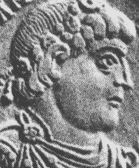
Claudian's de consulatu Stilichonis, (2, 250-5), written in January 400 is possible evidence for an expedition to Britain mounted by Stilicho in 396-8. The following is put into the mouth of Britannia, dressed in the skin of some Caledonian beast, her cheeks tattooed, her sea-blue mantle sweeping over her footsteps like the surge of ocean:
- "Inde Caledonio velata Britannia monstro, ferro picta genas, cuius vestigia verrit caerulus Oceanique aestum mentitur amictus: me quoque vicinis pereuntem gentibus inquit munivit Stilicho, totam cum Scottus Hivernen movit et infesto spumavit remige Tethys illius effectum curis, ne tela timerem Scottica, ne Pictum tremerem, ne litore toto prospicerem dubiis venturum Saxona ventis." (When I too was about to succumb to the attack of neighbouring peoples - for the Scots had raised all Ireland against me, and the sea foamed under hostile oars - you, Stilicho, fortified me. This was to such effect that I no longer fear the weapons of the Scots, nor tremble at the Pict, nor along my shore do I look for the approaching Saxon on each uncertain wind.)
Frere (1987) believed this was evidence of naval activity against the Irish, Picts, and Saxons, as Gildas mentions in is sixth century writings. If this is the case then it may well have taken place offshore of the line of forts and signalling towers along the northern Welsh coast.
The "XXth" legion, Valeria Victrix, based at Chester, appears to have been recalled to the continent by Stilicho about 402. Claudian's poem, De Bello Getico, indicates that the troops in question had done service against the Picts and Scots, as had the XXth under Hadrian and Pius:
- "Venit et extremis legio praetenta Britannis; Quae Scoto dat frena truci, ferroque notatas; Pertegit exsangues Picto moriente figuras." This legion, which curbs the savage Scot and studies the designs marked with iron on the face of the dying Pict.
The mention of the invasions of the Scots, the implication of coastal defence and the possible link with the XXth legion, may indicate that Stilchio was active in the Chester/N.Wales area. Soldiers based at Chester were still being paid in coins from the imperial mints until, but not during, the time of Magnus Maximus (383- 8), who perhaps removed the remaining regular troops from Chester when he invaded Gaul in 383. The Notitia Dignitatum, a list of officials probably compiled c. 400, mentioned neither troops at Chester nor the Twentieth Legion elsewhere in Britain.
The provinces of Britain were now isolated, lacking support from the Empire, and the setting up and pulling down a final series of usurper emperors as the soldiers supported the revolts of:
- Marcus (406 - 407), a soldier in Roman Britain who was proclaimed emperor by the army there some time in 406. All that is known of his rule is that he did not please the army, and was soon killed by them;
- Gratianus (407), acclaimed as emperor by the army in Britain in early 407. His army wanted to cross to Gaul and stop the barbarians who were attacking the empire but Gratian ordered them to remain (he should have known better). Unhappy with this, the troops killed him - and finally
- Constantine "III" (who actually listened to the troops). Constantine III was a British common soldier and invaded Gaul in 407, eventually occupying Arles, but in the process probably drained Britain of the last of it's Roman legions.;
It is noteworthy that the Roman troops in Britannia considered that they still had a chance of defeating the continental Roman troops (in 407 - at that time being governed from Ravenna). This does not support the older theory that Stilcho had completly drained Britain of troops in 401. In mainland Europe things were far worse - on 31 December in 405 or 406 several tribes of Germanic invaders, including the Vandals, the Burgundians, the Alans and the Sueves, crossed the frozen Rhine river perhaps near Mainz, and overran the Roman defensive works in a successful invasion of the Western Roman Empire. This crossing initiated a wave of destruction of Roman cities and military revolt in Britannia and Gaul. This was a mortal blow to the Western Empire, from which it never recovered.
The concept that Roman Britain ended abruptly in AD 410 is now outdated and generally has little support in the few facts that exist for the period. It is more likely that the end of Roman Britain was a slow decline which had begun as early as the late 3rd century and continued in western Britain long after the east had been colonised by Anglo-Saxon settlement. In the west, it is becoming more popular to discuss the 5th and 6th centuries as the "late antique" period rather than using other labels such as the sub-Roman or Dark Ages.
links and sources
- "Ruin" at "From dot to Domesday";
- British History Online - Roman Chester;
- Carla Nayland on the Roman Walls of Chester;
The Roman Fortress
Much of Roman Chester survived the Dark Ages and the subsequent re-building in Mediaeval times. Unfortunately, even mighty Rome could not stand up to Chester City Council in the 1960's when a great part of the surviving remains were vandalized in the name of "progress".
Key to map:
- Roman walls are shown with a black solid line
- 5/B - Barracks
- 4/G - Commanders Residence
- 1/P - Headquarters Building
- 8/T - Baths
- 2/S - Large building with various proposed uses
- 9&10/W - Workshops
- 6&7/O - Officers Quarters
- V - Hospital
- ii/H - Granaries
- 3/E - The Elliptical Building
- 15/C - Cemeteries
- 28/PG - Parade Ground
- 12/X - Extra-mural Buildings
- 17/Y - Harbour areas
- 14/A - Amphitheatre
- 29/Q - Quarry, and Minerva Shrine
- 13/M - "Mansio" -official inn
- 16/Br - Roman Bridge
The Romans positioned the larger than normal fortress high on a sandstone bluff above the marshes. The fortress covered 60.90 acres, 20% larger than those in York and Caerleon, which were founded at the same time. Free from the floods of winter and the ever-changing shorelines of the estuary, the bend in the River Dee provides protection on two sides – south and west. It is also the lowest bridgeable and fordable point on the River Dee before it becomes too wide and treacherous. Drinking water was piped in from a spring in the suburb of Boughton. It's location on the bluff left the highest point at Northgate and the land sloping away on both sides and southward, allowing for an effective sewer and drainage system.
The fortress was designed in the standard "playing card" shape, with some modifications to the normal plan of buildings. It had four gates, corner towers and interval towers between the gates. The Roman gates had double arches and the Roman Eastgate had a statue of Mars, the Roman god of war, in the middle of the two arches. A fosse or ditch was dug around the north and east sides to provide extra protection. It has been calculated that the fortress was designed to accommodate 6,000 soldiers. The internal buildings consisted of barracks, baths, a hospital, a granary and some "headquarters" buildings. The main fortress baths were located halfway down the modern Bridge Street on the right-hand side. The full plan of Roman Deva is still not known because only limited excavations have taken place following demolition work of later buildings. It has been speculated that a Roman temple may have existed under Chester Cathedral – this is yet to be proved.
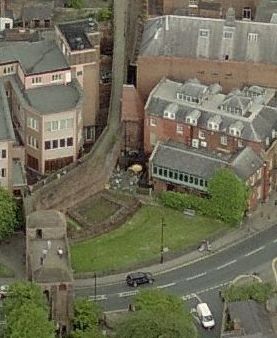
The original fortress was constructed of timber and replaced later with a stone fortress. Traces have been found under the Amphitheatre and market hall of pre-fortress buildings on a different alignment. It has been speculated that a forward camp was established before the first timber fortress was constructed. The castle hill is also a possible site for such a camp. The timber fortress would have looked like the one reconstructed at Lunt Roman Fort.
Local sandstone was quarried from the south of the river around the area now called Edgar's Field to provide building material for the fortress and its buildings. The Roman quarry face is still visible today on the outcrop of rock in the field. Through excavations, it has been established that many of the stone buildings were not completed and they were left abandoned for as much as 100 years before they were completed to a slightly modified plan.
The second Legion built their fortress in the territory of the Cornovii. It soon became the main base for Legio XX Valeria Victrix, the 20th Legion, which used it as a port administration base and military fort. It was then one of the principal towns of Roman Britain, with many relics remaining today, including parts of the original Chester Roman walls, parts of a hypocaust system from a Roman bathhouse, and a strongroom from the 'principia', as well as the street pattern at the Cross, where the four main streets intersect and half of its original amphitheatre (controversially, the other half was built over, but is currently being excavated).
Parts of the Roman "quay wall" of the port can still be seen under the medieval walls at the racecourse. It has been suggested that this quay wall formed a platform for a jetty which stretched out across the river to allow ships to dock at low tide.
Later on in the fortress's history, settlements began to develop outside the fortress walls between the west wall and the port area near the river. Mansion buildings were created for wealthy Romans outside the Walls, an example of which was discovered on Castle Street. Roman shops and workshops lined the incoming roads and to the south as far away as modern day Eccleston. A new bath complex was established outside the fortress walls on the modern Watergate Street under the site now occupied by Sedan House.
The Roman fortress was occupied up to the 4th Century. Roman coins have been found in the area dating up to this time. The fortress was described as waste land in the 6th century. It is thought that some Roman buildings remained standing as late as the Norman period. This is the reason why Northgate Street is dog-legged in shape. A massive column base of the Roman 'principia' can be seen through the floor in a shop (which used to be Blacks). Much of the Roman masonry was robbed out and reused in later periods.
A recent Timewatch investigation by the BBC speculated that, from the size and scale of the fort, had the Roman Empire not begun to collapse, Deva would have become the Roman capital of Britain and a launch post for invasions on Ireland. In fact, recent discoveries of a fort in Ireland suggest that at least one foray was made.
Although both Gildas and Bede located the Roman martyrs, Julius and Aaron, in the "City of the Legions", this is generally identified as Isca Augusta (Caerleon) rather than Deva, because of the chapels there dedicated to the two saints from at least medieval times.
Roman Walls
No Roman army ever camped even for a single night without fortifying its position. The shape of such a marching camp, was a rectangle which measured (for a legion of 6000) roughly a quarter mile on two sides and rather more on the other two. It would take around twenty minutes for a person to walk around such a rectangle. The remains of such a marching camp can be seen in ariel photographs near Upton. The marching camp would be constructed by digging a ditch (fossa), about nine feet broad and seven deep, the earth from which was thrown up so as to make an embankment (agger) on the inside of the ditch.. The top of the agger was sufficiently broad for troops to stand on it and it could be further defended by a fence of wooden posts (vallum). The internal layout of these marching forts was more or less standardized, and when permanent garrison forts were built they followed a similar plan.
The remains of a roman marching fort can be seen in some ariel photographs, and one such fort can be seen under the A41 just north of Chester. Putting up a regular marching fort so close to the city does not seem to make much sense, so this may have been a fort which pre-dated the city, or one which was built for training purposes - possibly prior to a major campaign. This could have been prior to the hiatus in construction work from about 120 to 210 CE. There is very little to see of these forts on the ground and many have been almost "ploughed flat" over the years.
For permanent forts the agger would have a core of piled sand, clay or rubble covered in stacked turves. A timber walkway would top this with a palisade of posts on the outward side and a wooden safety rail on the inner edge.
The Roman walls of Chester were once thought to have been rebuilt in stone from the middle of the second century CE. There has been much debate on this. However, it now appears that the facing of the ramparts with stone started earlier and the rebuilding of the ramparts with solid stone was well underway by the end of the first century, i.e. within a few years of the establishment of the city. This would have been a massive undertaking, as the stone walls, towers and gates comprise some 55 thousand tons of stone (about 70 thousand Roman wagon-loads).

The Roman walls of Chester were built to a very high standard of large sandstone blocks without mortar, a technique known as opus caementicium and usually reserved for temple or city walls rather than those of a fortress. Along the walls the Romans built 34 or 36 square towers about 60m (a bowshot) apart. The corner towers would have mounted a ballista. The Roman walls enclosed just less than half of the area enclosed by the current city walls (see map above), but a larger area than most Roman forts. There were four gates in the locations of the present Northgate (Porta Decumana) and Eastgate (Porta Principalis Dextra), at the junction of upper and lower Bridge Street (Porta Praetoria), and where Watergate Street meets St Martin's way (Porta Principalis Sinistra).
Some remains of the North-East and South-West corner towers can still be seen. The base of the South-West corner tower being the better of the two. The location of the South-West corner tower was probably influenced by the presence of a natural gully which now forms the course of Souters Lane. This gully would have provided a defence against anyone trying to encircle the city from the east and cut the route from the south gate down to the bridge over the River Dee. A similar gully lay further to the west near the site of the Grosvenor Bridge and on the edge of what is now the Roodee, although the topography there is much altered. Together these two gullies may well have significantly influenced the exact location of the Roman Walls. Three other convenient gullies or shallow vallies also influenced the layout: a pair on either side of the River Dee at the foot of Lower Bridge Street and in Handbridge, which determined the position of the Roman Bridge and one near the site of the Watergate.
links
- List of Roman finds (defences);
- Roman tombstones recorded in the North Wall at Deanery Field at Revealing Cheshire's Past
- Roman Fortress Defences at Chester (Deva) listed at Revealing Cheshire's Past;
- A series of papers read before the Chester archaeological and historic society, etc. Earwaker, J. P. (John Parsons), 1847-1895 ed.
- The Planning and Date of the Roman Legionary Fortress at Chester;
- THE PRATA LEGIONIS AT CHESTER;
Barracks
The garrison at Chester possibly consisted of about 5,500 legionaries per se. They lived in barrack blocks which would initially have been made of wood but were later replaced by stone (all those investigated so far show replacement with stone soon after 200). The blocks were arranged in a similar fashion to the tent lines of a marching camp. The blocks comprised 11-12 individual sets of two rooms for each squad ("contubernia"), with a verandah and a separate accommodation for the Centurion. At the far end of the block from the Centurion was a latrine connected to the sewers (Centurions often had the benefit of an "inside toilet"). The blocks were arranged in clusters of 12 or 24, mainly in the corners of the City.
The inner room of each dwelling unit slept eight men and, given their size, bunk beds were probably fitted. These men would eat, sleep, drill and march together, fight the enemy side by side, go on duty at the same time, share their ablutions, and also spend much of their off-duty moments in each-others company. It is apparent from a pottery graffito found in the Neronian fortress at Usk, that each contubernium had a leader appointed from among its members - probably based on the length of military service - who was presumably responsible for the general conduct of the men and would also ensure that the rooms allocated for their use in the barrack-block were kept in order. The inner room also contained a hearth for heating and cooking. The outer room (arma) was about 3m deep, the inner (papilio) about 5m deep and the width was 4m for both. With 8 men in a single squad, this means that 80 men (a full century) would live together in a single block. The front room may have housed the squad leader or may have been used, as its name suggests, for storage of weapons and other kit.
The floors were sand or clay for the men and possibly concrete for the officers. Much later some of the rooms even had a hypocaust installed. Excavations have shown that the walls were decorated with painted plaster.
The roofs of the early stone barracks were tiled with red ceramic tiles of the type still widely used in Rome today. The tiles were manufactured at Holt (where possible remains of Roman barracks have also been found) and Saltney and were probably transported by river. Later, tile manufacture seems to have ceased and roofs were covered with Welsh slate. The slate industry in Wales began during the Roman period when slate was used to roof the fort at Segontium, (now Caernarfon), originally roofed with tiles, but in later remains also showing numerous slates, used for both roofing and flooring.
Robert Newstead of the Grosvenor Museum excavated parts of barracks in Deanery Field in the 1920's and 30's. In the 1970's and 80's there were further excavations and together these turned-up many relics of the everyday life of the Roman soldier including: miniature altars, gaming pieces, a small lock made of bone, and a stamp with backward lettering used to mark bread baked by a certain Lucilius Sabinanus. These diggings also show that for a while some of the barracks were abandoned for long enough for a layer of debris to accumulate before reconstruction.
Further barracks in Chester remain to be excavated. There are believed to be extensive remains near Hunter Street, but there has been some debate as to whether these should be left buried (under a proposed department store) or exposed. The barracks of the first cohort were usually located on the right-hand side of the principia, ranged parallel to the side wall of the principia, with the houses of the senior centurion on the Via Principalis street frontage.
Commander's Residence (Praetorium)

The house of the commanding officer was based on the typical Mediterranean atrium house favored by the Roman ruling classes—no concessions were made to local conditions. Villas were designed to provide shade and escape from the heat, and consequently the living quarters were arranged around an open courtyard. As commanding officers—and their families—came and went, the building would have been modified and remodeled to suit the new occupants. Typical modifications might have included the building of hypocaust (sub-floor heating systems) and the addition of a private bath-house, both of which seem to have been included in Chester although the Praetorium has not been the subject of much excavation.
The hypocaust in the "Roman Gardens" at Chester has been reconstructed using the pillars (pilae) recovered in 1863 from one of the rooms in the main bath building (thermae) of the Roman fortress in Bridge Street (see below for more on the baths)
Officer's Quarters (Praetentura)
The praetentura, the houses of the six military tribunes, occupied the street frontage on the south side of Eastgate Street. Unfortunately, reckless development during the 1960's destroyed any surviving structure. Dennis Petch, Curator of the Grosvenor Museum during the 1960s, is reported to have recalled bitterly (concerning later development of this location) that:
- "..the developer refused to give permission for any formal excavation once his work on the site had begun... with customary efficiency Laing's immediately commenced the earthworks for underground storage and delivery bays for shops to be built in the precinct above... it was soon clear that the great colonnaded hall under the arcade formed part of the same complex and was in all probability one of the earliest of the covered palaestrae of the north-western provinces of the Roman Empire. Even after the great size and high degree of preservation of the building had been clearly demonstrated, and protests against its impending destruction were made at local and national level, commercial considerations prevailed, effectively limiting our gathering of site data to piecemeal observation and recording at the pleasure of the contractor, supplemented by very little formal excavation. This was not a very satisfactory way of proceeding in the case of such an important building which had apparently begun its life in the early years of the fortress and was still in use in the third century. This debacle attracted a great deal of public attention and criticism, and the upshot was a general conviction that such vandalism should not be allowed to recur."
One relic of these buildings survives to the rear of Watergate Street. To find it, enter the covered passageway near Bishop Lloyd's House and at the far end look over the wall.
Headquarters Building (Principia)
This was the administrative and religious center of the fort and was the most important building in any Roman fort. It was situated at the center of the fort where the Via Praetoria and the Via Principalis crossed. The existence of this building is the reason that modern day Northgate Street and Bridge Street do not line-up.
The building probably followed the standard plan and comprised an open colonnaded courtyard enclosed on three sides by offices and/or stores. At the rear of the courtyard stood a roofed cross-hall or "basilica". At the rear of the cross-hall were a number of smaller rooms (usually five). The central one of these was the legionary shrine ("aedes/sacellum"), probably the most important room in the city.
The courtyard would probably have contained a platform were sacrifices were made and the omens read. The current location lies under St Peter's Church. In Roman times it would have been the place where guard details were assembled and changed. Small parades and ceremonies would also have been held here. Behind St Peter's, there is still an open space (St Peter's Churchyard) where a part of the courtyard stood. If you stand there today, you may well be standing on (or above) the very spot where the sacrificial platform was located.
The basilica housed a few shrines (and the image of the Emperor) and was used for more important ceremonies including the "Rosaliae Signorum" when the military standards (signa) were brought out and adorned with roses in a supplication as part of rights associated with the dead. When it was not being used for ceremonial purposes the basilica was the place where orders were issued, imperial decrees read out and the officers of the legion addressed by the Legate.
The central room at the rear of the Headquarters was the "sacellum", the regimental shrine, which served as a focal point of the headquarters. The standards of the units were kept here. In the centre of the room was a sunken pit which acted as a "strongroom" (Aerarium) for the regimental pay chest. The money was kept here to deter thieves who would be committing "sacrilege" if they stole from the shrine. The legionary standard bearers acted as treasurers of the funds keeping track of what money was paid in and out.
A Roman soldier earned a one-time "praemium" or discharge benefit upon completing his service (sixteen years for the Praetorian Guard, twenty for regular duty in the army). At the end of Augustus's reign, the pension for a Praetorian guard was 20,000 sesterces (HS), and that of a legionary 12,000. In the 1st century, a legionary's retirement benefit would have amounted to about 12 years of service pay. It is very difficult to make any comparisons with modern coinage or prices, but for most of the 1st century AD the ordinary legionary was paid the equivalent of 900 Sestertii per annum, rising to 1,200 under Domitian (81-96 AD), the equivalent of around 25 Sestertii per day. Half of this was deducted for living costs, leaving the soldier with about 12 Sestertii per week. In comparison, a private soldier in the Peninsular war (under Wellington) would earn about seven shillings (35p) a week (at the same time the average weekly laborer's wage was around 6-10 shillings - roughly equivalent to £30-50 a week in 2013 money). In 2013 the average pay for a British "squaddie" is about £20,000 per year, whereas the average income in the UK is about the same. Given that the Roman legion in Chester had something over 5000 members, the money held in the strongroom for pay and pensions at any given time may well have been worth several million in present day cash - quite a few chests of silver coins.
The Roman strongroom can still be seen in Hamilton Place. To find it, walk along Northgate Street to the Town Hall square and head down the alleyway next to the "Dublin Packet". It is a sunken pit dug into the local stone behind a glass window.
The Baths (Thermae)
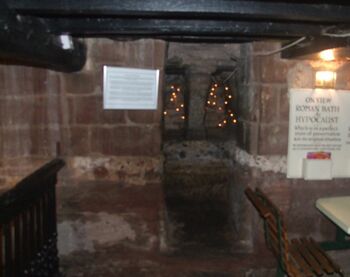
Like most Roman settlements, Deva Victrix had a large legionary bath complex for the soldiers to wash and to use for leisure time. The remains on the east side of Bridge Street were largely destroyed during the construction of the Grosvenor Mall. It has been estimated that the baths used between 500,000 and 750,000 litres of water a day, which was supplied from the springs in Boughton. Water was piped in large lead pipes underground from a branch off the main aqueduct near the Eastgate, downhill to the baths on Bridge Street. The water was then held in large tanks with concrete foundations, and then fed through the complex. Waste water would have been fed downhill using gravity to the river. The water was fed through 24 hours a day.

The positioning of the baths complex within the Roman fortress of Deva would have been on one of the main streets; the Via Praetoria, close to the south gate. It was placed in the first building strip or "scamnum" of this block, which is unusual for Roman planning - the usual Roman procedure would be to place it in the second strip. The bath complex consisted of an entrance room (vestibulum), an exercise hall (basilica thermarum), a sweating room (sudatorium), a cold room with a cold pool (frigidarium), a warm room (tepidarium), and a hot room with a hot plunge bath (caldarium). An unsheltered exercise yard (palaestra) also formed part of the complex. The baths had mosaic floors and were heated by a hypocaust under-floor system connected to three furnaces. The ceilings of the baths were domed with lines of terracotta tubes to support the structure. Part of the Roman hypocaust remains in situ under the Mall and can be viewed from the cellar of the restaurant on 39 Bridge Street. The remains consist of a number of local sandstone pillars on a concrete base supporting a buried Roman floor. Also remaining in situ is part of a fine Roman mosaic floor, located under St. Michael's Arcade by the Bridge Street entrance. It is known that the bath complex stood for a long time after being abandoned by the Romans. When part of the site was excavated during the demolition of the Feathers Hotel, the floor was found intact with a 0.4 meter covering with dark soil from the Saxon period, followed by remains of the collapsed roof. Five columns from the exercise hall with parts of another hypocaust can be viewed in the Roman Gardens off Pepper Street (which is not their original location).
Some of the baths remains can be viewed in situ at 39 Bridge Street. In the west cellar wall are sections of Roman bath house masonry, and the medieval rear walling contains a rebated doorway opening into an exposed Roman hypocaust, perhaps restored when found during development in 1864; these roman remains are thought to date from the second century AD. They consist of 27 square columns in a rectangular chamber which originally contained 32 columns in eight rows of four. Also in the east wall are compound corbels, comprising of four stones, positioned over the doorway and dating to circa 1300.
A new bath complex was later built outside the walls. When this bath complex was destroyed by development in 1964, parts of the walls were still standing in situ to a height of up to 13 feet (4 m), hypocaust and mosaic floors were still intact, and large sections of collapsed roofing vaults (barrel-vaulted concrete, estimated to have stood 53 feet above floor level) lay on the floors. The site is now occupied by the rather ugly 60's office block "Norroy House" (now vacant and due to be demolished). In this area, adjacent to the part of the west wall, is the foundation of an ancient Roman bath house, which is pierced by the furnace arch of a hypocaust. Also found on the site were the remains of a "sudatory" (sweating bath) and many tiles stamped with the wild boar motif of the XXth Legion, considerable amounts of coins of the reigns of Hadrian and Trajan and an altar dedicated to Aesulapius the Roman Goddess of healing who was always honoured at legionary bath houses.
Large Building
The largest building in Roman Chester was located in the center of the city and covered what is now the upper end of the Town Hall Square. The building consisted of a courtyard surrounded by small rooms with wide doorways opening onto the courtyard. The courtyard is the origin of the Town Hall Square.
The purpose of the building is not clear and at various times it has been prposed to have been stables, a hospital or a vast store-house. One additional theory was that this was an administraion building for the use of the Roman Governor of Britain. Chester would be an ideal place from which to govern the province - it had the best habour on the west coast and was both equidistant from and well-linked by roads to the Roman centers at Caerleon, Carlisle and York. The fortress of Deva was the largest in Roman Britain and has many features which are not found elsewhere in the standard plant to which the fortresses were built. The large building and the adjacent eliptical building are among these.
Similar buildings are found elsewhere, but not in legionary Camps. An example is the forum in Roman Barcelona but that was a Roman town rather than an almost purely military site. It is possible, but only a speculation, that at some point the Romans may have considered converting the legionary base into a civilian city.
However, pressure elsewhere on the borders of the Roman empire - possibly in Dacia (modern day Moldova/Romania) - compelled the Romans to withdraw troops from the far north of Britain in the late 80s AD. Inconclusive archaeological evidence suggests that the huge legionary fortress at Inchtuthill (in Tayside, Scotland) was systematically dismantled and abandoned in 87 AD, less than four years after it was built - Legio II Adiutrix had been called to Moesia from its base in Chester to deal with a Dacian invasion in 86 and XX Valeria Victrix was obliged to move back south to take its place. By 100AD emperor Trajan, required stable borders and more troops for a further campaign against Dacia. Trajan ordered a complete withdrawal of Roman forces from what is now Scotland. A new frontier, comprising road, forts and signal-stations, was established on an east-west line through modern Northumberland between Newcastle-upon-Tyne and Carlisle on the Solway. Vindolanda was one of the forts on this so-called 'Stanegate Line'. In 122AD construction of Hadrian's Wall started, and while there was a further move north to the Antonine Wall in 142, this was abandonned in 163. Apart from some possible small-scale landings, the Roman invasion of Ireland never got underway, and with the abandonment of Scotland there was little support for making Deva the "capital" of the province. Thus, while the large building seems to have been given priority early in the construction of Roman Chester (even over the commander's residence), it was then not completed for two decades and apparently along much more simple lines than was originally intended.

Workshops (Fabricae)
A Roman legion held within its ranks a formidable array of artisans, whose skills excused them from normal duties, they were thus termed immunes. Vegetius lists several skills which would qualify a soldier among the immunes; 'engineers, carpenters, masons, wagon-makers, blacksmiths, painters and other artificers' (epitoma rei militaris, II.11) - all of which would have been employed in the fabrica of a legionary camp under the command of a praefectus fabrum .Other trades included farriers, surveyors, shipwrights, glaziers, fletchers, armourers, hunters, butchers, grooms, plumbers, bronze-smiths, lime and charcoal burners, and keepers of sacrificial animals.
Massive amounts of material were used in the construction of the walls and the the buildings within the walls (with a footprint of about 25 hectares). Even the initial wooden construction would have required around 25,000 tons of wood and another 6000 tons for associated works such as the bridge, amphitheater and construction camp. This equates to about 40,000 wagon loads of timber. The area of woodland that would need to be cleared to supply this amount of timber depends on the yield and could have been anywhere between roughly 100-400 hectares (0.5-1.5 square miles, between 4-16 times the size of the roman city or about 100-400 international rugby pitches).
Roman Harbour
There as been much discussion about the so-called "Roman Quay", which extends for a considerable distance long the edge of the Roodee under the medieaval walls. Opposing theories have stated that Roman ships would tie-up along this "quay" for unloading, or that the "quay" is actually a defensive structure and the water depth over much of the Roodee would not have been sufficient, except perhaps at some high tides, for shipping to approach the "quay". Excavations for the construction of a gasworks (since demolished) revealed what could be interpreted as the far end of a pier, leading to the suggestion that this pier would be used for loading/unloading.
Many Roman relics have been found between what would have been the western wall of the fortress and the line of the "Roman Quay". It is clear that this was a populated area and it is known to have contained a large baths complex which was used both the the military and the civilian population. This has led to the theory that the "Roman Quay" was either the base of a defensive structure, or the retaining wall for an area where the land had be raised and leveled for building purposes (in which case it would also function as a "flood defence").
It has been proposed that Roman Chester was initially intended as a pricipally naval base, supported by the fact that the initial occupants were the marines (from the Ravenna navy) of Legio II. Other factors lend further support to the idea. First, the legionary depot at Wroxeter appears to have remained in commission, though perhaps merely under care-and-maintenance. Wroxeter was sufficiently well situated for campaigns in the Marches, central and north Wales, and probably southern Brigantia to make the relocation of a legionary depot to Chester merely to control the Ordovices and Brigantes unnecessary. Chester indeed may not have been well placed for campaigns in north Wales, since a direct overland route was made difficult by marshlands to its southwest. Moreover it was located somewhat away from the existing main roads leading north on the west side of the Pennines.
Granaries (Horreae)
These were located near the Roman harbour gate, suggesting that the bulk of the grain arrived by river. Nowadays this is a site found between Watergate Street and Commonhall Street, bounded to the west by Weaver Street and to the east by Old Hall Place (this includes the former site of the offices of the Chester Chronicle). Bulk shipments of food, especially grain, had to be shipped by water wherever possible, given that the cost of overland transport, (at least according to the transport tariffs cited in Diocletian’s Edict on Maximum Prices) would quickly become unsustainable for such large quantities of cargo. The payload capacity of most Roman freighter-ships of the period was in the range of 10,000–20,000 modii (70–140 tons).
Typically, a Roman garrison would store some six months worth of grain, and analysis of sewage from latrines indicates the legionary diet was mainly grain-based. Indeed grain, provided as part of a soldier’s government-issued rations, is the only component of the military diet for which an amount is specifically cited, and based on this it seems that a soldier’s grain ration (about 1.5kg) composed approximately 60-75% of his daily food supply (although a Roman soldier’s daily meat ration contained almost twice the calories-per-gram of his grain ration), and baking bread would have possibly been a daily task for the members of the garrison at Chester. In fact, part of a roman soldier’s equipment was a small skillet to bake bread.
Grain is susceptible to damp and the depredations of birds/rodents. Excavations in 1954-56 and 1988 show that the three granaries were built of stone, with 3ft thick walls, and each had a ground area of about 50m by 15m, comprising a typical pattern with a series of close-set longitudinal sleeper-walls possibly supporting a stone-slab floor away from damp. Grain would have been stored in large bins in these granaries with a central walkway down the middle of each. A cubic meter of grain (depending on the type) weighs about 0.8 tons. Three 50x15m granaries stacked to a two meter depth with a 5m passage down the middle of each would contain 2400 tons of grain.
Ventilation shafts crisscross both the sleeper walls and the outer walls of the building to facilitate airflow. The roof would have been of tile rather than thatched to reduce both vermin and the risk of fire.
Estimates for the military presence in Britain range from a minimum of 40,000 men, up to a maximum of 63,000, with a typically accepted average of 50,000 (the total British population at the time would have been around 2,000,000 at most – so the Romans are 2-3% of the population, which fits with the Roman Empire spending 2-3% of GDP on the legions - Britain today spends around 2.5% of GDP on the military (such comparisons are said to be misleading - taxes (and compulsory services) to support the Roman military would have taken a much greater share of surplus per capita production).
The garrison at Chester possibly consisted of about 5,500 legionaries per se, with a possibly an additional 1000-1250 slaves and servants, bringing the total up to around 6,500. Add to this the needs of horses and other animals and the annual grain demand would be around 5000 metric tons. Three “full” granaries would be about a 6-month supply, and around 100 tons per week (one shipload) would need to be supplied to maintain this reserve.
Iron-age farming methods possibly yield at best about 1 ton per hectare (an international Rugby field is about a hectare), so around 5000 hectares (50km2) under grain would be needed to supply the fortress with grain annually. 50km2 is about 2% of the area of modern Cheshire. Of course, only a small proportion of the land would be suitable for cultivation, and there would be limitations on the labour available to work the land.
When Tacitus relates the grievances of the mutinous legionaries of 14 A.D., the perennial military complaints of poor, insufficient, or otherwise unsatisfactory food are not among them .One of the primary points of contact between the Roman military and the civilian populations must have been regarding food, whether it was exacted as taxes or purchased by the soldiers themselves. Numerous forts in Britain have produced evidence of oysters (both natural and farmed), mussels and edible snails which may have been introduced to Britain by Roman garrisons. Shellfish were often imported far inland to military sites, for example, to Hadrian’s Wall from southern England.
The Elliptical Building
Since it first came to light in 1939, the 'Elliptical Building' has been one of the great mysteries of Roman Chester, and indeed has been described as the most mysterious building in Roman Britain. It has been suggested that the entire layout of the city was designed so that it could be accommodated. The ruins of this unique building were first uncovered during the demolition of "slums" in 1939, the remainder was exposed during "rescue excavations" in the late 1960's. The Elliptical Building appears to be a unique building to Chester, as no other example of such a building is known to exist in the whole Roman Empire, and is of international importance. Its function is still not fully understood any evidence from it is highly valued. During the refurbishment of the Forum Shopping Center (1995) its foundation was once again uncovered. However much of the northern part of this unique building was destroyed during the construction of the underground car park beneath the Market Hall in the 1960's.
While the overall footprint is oblong, the shape of the central part of the building is roughly that of a "vesica piscis". That is the shape formed by the overlap of two circles. The building can be dated by the inscription on a lead water-pipe leading to the central courtyard fountain which records its manufacture 'during the ninth consulship of the emperor Vespasian and the seventh consulship of the emperor Titus, in the governorship of Gnaeus Julius Agricola’ - (the pipe is one of those mentioned above, now in the Grosvenor Museum), that is during the first half of AD 79.
The building work seems to have been stopped after a very short period of time. While the degree to which the construction of the building had progressed varied throughout the complex, in many cases work had hardly progressed beyond the laying of foundations and the completion of masonry up to ground level. In other places not even the foundation material had been laid. In no area had the process of forming the internal floors or external surfacing been started. The original drain from the fountain was re-routed during the early work, but this modification was incomplete when the building work stopped. The Elliptical Building was not the only construction project to be interrupted at this time; work on a massive complex to its east was clearly delayed as was the completion of buildings to the north. It has been suggested that the deployment of much of the Chester garrison, Legio II Adiutrix, to Scotland for Agricola’s campaigns (80-83) is the most likely explanation for this interruption. This would put the cessation of work before or around AD 79, meaning that at most around five years of work had been done on the site.
The site of the Elliptical Building lay derelict for most of the next 150 years, and many of the monolithic blocks of stone employed in the foundations of the colonnades and piers were removed for re-use elsewhere. Part of the site was briefly occupied by a group of timber workshop buildings. After the demolition of these workshops at the beginning of the 2nd century, the site of the Elliptical Building remained derelict and was used as a general dumping-ground for various forms of rubbish. By the time the decision was taken to construct a new building on the area c AD 225 the rubbish was a metre deep. Gold-working crucibles were found at the north end of the building, together with a gold solidus of the Emperor (and usurper) Magnentius (350-353 AD).
Remarkably, the design of the new building (c. 225) followed that of it's unfinished predecessor in some ways and was an improvement of it in others. It has been suggested that this must have meant that the designers of the new building had access to the plans of the original from a century and a half earlier.
Some imaginative hypotheses have been put forward for the purpose of the building. These have have included a theater, a market-hall and a retirement palace for [Cartimandua] (ruled c. 43 – 69) following her ejection from Brigantia by the anti-Roman party. The theater theory is particularly ironic, as part of the redevelopment of the site in the 1960's placed the "Chester Gateway Theater" almost on top of the building. Others have speculated that the each of the twelve chambers around the central courtyard may have each had as its focus a statue of one of the principal deities of the Roman State - Jupiter, Juno, Mars, Minerva, Vesta, Diana, Apollo, Ceres, Neptune, Janus, Mercury, and either Dea Roma or Vulcan.
A religious or at least ceremonial use for the building seems probable due to the general layout. Twelve chambers are arranged around a central space equipped with a fountain, which is quite an extravagance. The building has its own bath house. The rest of the block is taken up with rooms which do not intercommunicate except in small groups, and in most cases to get from one room to another one needs to go outside. In the later design it would appear that several doorways have be passed to reach the central chamber.
It is even possible that the twelve chambers had something to do with astrology. The Romans were actually quite keen on this, and one largely unknown but very scholarly book on the subject was written in verse by the author known as Marcus Manilius. Manilius' poem is in five books, with about eight or nine hundred verses to a book. The English classical scholar and poet A E Housman (best known to the general public for his cycle of poems "A Shropshire Lad") worked on a translation for years and is still considered authoritative on Manilius. One surprising thing about Manilius is that he can express fairly complex mathematical ideas in poetry.
- Book 1 gives an overview of all the visible constellations.
- Book 2 describes the signs of the zodiac and the different "aspects," or geometric angles, of their relations to each other (and just as in modern astrology, 60 degree angles or "trines" are good, while 90 degree "squares" and 180 degree "oppositions" are generally bad).
- Book 3 gives a system of what astrologers call "houses": areas of human life governed by the twelve sections of the heavens. In Manilius' system these areas are Home, War, Business, Law, Marriage, Wealth, Dangers, Social Class, Children, Character, Health and Success. The third book also discusses what modern astrologers call "ascendants" or rising signs, and at a certain point this book flirts with the possibility of revealing the great secret that true astrologers were thought in antiquity to possess: namely, the method of predicting a person's fated life span.
- Book 4 describes the qualities of specific degrees of the 360 degree circle of the zodiac and also explains which regions of the inhabited world are governed by which astrological signs (Italy is governed by Libra, if you're curious, and Greece is under Virgo).
- Book 5 is concerned with "paranatellonta." These are the constellations outside the zodiac whose rising and setting also exercise influence over human life. This fifth book probably includes some material drawn from systems of astrology much earlier than the one practiced in the Hellenistic Mediterranean. Manilius seems to know quite a bit about non-Greek constellations, and he probably had access to one or more Egyptian sources in Greek translation.

By 2005, plans were already being made to demolish the Forum Shopping Center and redevelop the site again. In these plans site of the Elliptical building is to be occupied by an Elliptical Shopping Center...
sources and links
Cemeteries
By Roman law, the dead were buried outside the fortress in cemeteries along the incoming roads to the north and east. Some were cremated and buried in urns, others buried in stone-lined tombs. Elaborate monuments lined the roads. Sometime in the later Roman period, these monuments were broken up and used to repair the fortress walls. During the 19th century, these tombstones were recovered from the north wall and now form the best collection of Roman tombstones in the UK. They can now be seen in the Grosvenor Museum. Many graves were uncovered when the Infirmary was being built and enlarged. Chester historian Frank Simpson recorded that, in 1858 (while preparing railway sidings to accommodate exhibitors at the Royal Agricultural Show) workmen discovered several Roman tombs, which contained such articles as terra-cotta lamps, clay vessels and coins of the period of Domitian (Roman emperor from 81 to 96).
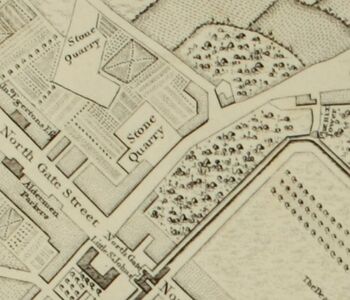
Burials also took place in other locations as in the case of Callimorphus a Greek trader, who died together with his son Serapion while on a voyage to Chester about AD 90. It's possible that his brother Thesaeus accompanied them on the journey and so was able to pay for what would have been a rather expensive monument. How Callimorphus died is unknown, but father and son dying together suggests a common cause, such as disease, rather than accident.
The Quarry
The second fortress was constructed of local sandstone, which was quarried from across the river to the south of the fortress. Traces of the quarry can still be seen today in Handbridge. A large amount of sandstone was taken and used in the construction of the fortress wall and the many buildings inside. On the old quarry face, near an old ford, was carved an image of the Roman goddess Minerva (see "Minerva Shrine"). It may have been carved by the workmen of the quarry for protection.
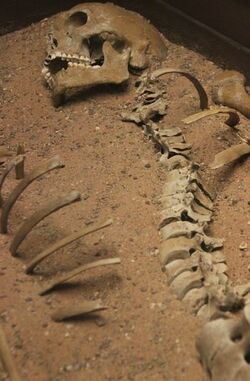
Another possible Roman quarry site at Delamere Street lies just outside the Northgate of Roman and medieval Chester and in recent years has been subject to intensive investigation as part of the Gorse Stacks development, and the redevelopment of Delamere Street. Quarry pits had been dug for building material and subsequently infilled with rubbish from inside the fortress dating to the late first to early second century. Investigationns have led to a large small finds assemblage. Little sign of these quarries was visible until the recent excavations for the foundations for new development when the quarries were clearly exposed. However the quarries can be clearly seen on the Lavaux Map from 1746.
Nearby, the canal, sitting in a rather deep cutting, follows the line of a Roman ditch (fosse) before the wall but the depth of the cutting along the north wall seems excessive. However Simpson's "Walls of Chester" does seem to suggest that very little extra work was needed for the construction of the canal cutting:
- "The contractor for the canal when making his excavations found that he was exactly on the line of the old Roman fosse, and that, instead of excavating solid rock, he had only to clear out the accumulated earth and rubbish: by this economy he was enabled to make a considerable fortune."
The above version suggests that hardly any actual rock needed to be cut. However, maybe it is just an "urban legend", or maybe the clever Romans decided to quarry the stone for the north wall from directly outside of the Northgate.
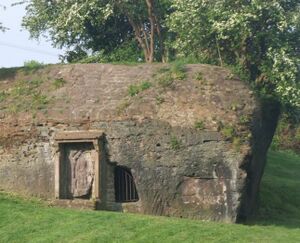
The Mansio
This was located outside of the Roman Walls and was an official stopping place, maintained by the central government for the use of officials and those on official business whilst travelling, using the imperial post service ("cursus publicus"). Establishments of this type also had to provide facilities for changing relays of horses used for the carriages and gigs of the couriers, and for the storage of government goods in transit. In the later Roman empire mansiones tended to be used as police posts and collecting points for corn tax. Use of these inns was strictly controlled by travel warrants, since the service tended to be heavily overloaded abd enormously expensive. In the early Roman period the capital costs and running expenses of the service had to be met by the local government authorities, who also had the duty of organising the system, However, in the reign of emperor Hadrian (AD 117-138) the state took over their responsibilities.
It is possible that the skeletal remains of a boy found in the base of a well at the Mancio near Chester Castle and the signs of a fire from the same time are the result of the "barbarica conspiratio" (367 AD). Certainly no-one seems to have made any attempt to fish the body out of the well at the time. The skeleton of the boy is now in the Grosvenor Museum, and it is easy to see that sometime earlier in life he had broken his leg badly and probably walked with a pronounced limp. However, associating a fire with civil strife is a weak connection, bakers shops, blacksmiths and even hotels have been known to burn down for many other reasons.
Roman Bridge and Roman Roads
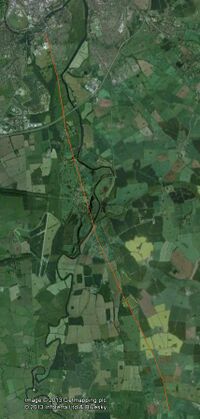
Watling Street (west) is the name given to the Roman road on a north-south alignment linking the northern legionary fortress at Chester and with the southern fortress at Caerleon near Cardiff by way of Wroxeter where the road connects with the main Watling Street that runs from the south east coast through London then onto St Albans (Verulamium) and Wroxeter (Viroconium). The route of Watling Street (west) can be followed from Chester to its crossing point of the Dee at Aldford and then onto Malpas where it disappears from the landscape.
Presumably Flavian in date at latest, the Roman Road left the south gate of fortress and crossed the River Dee at approximately the same point as the Old Dee Bridge.
Roman roads can not only be traced by looking for straight sections of modern roads marked "ROMAN ROAD" on a map. Frequently, parish boundaries follow the line of Roman Roads. Also, field-edges, or even rows of trees, may align to form a straight line where the road is less visible. Place names such as "Street", "Stratford" (i.e. "Street Ford") and "Trafford" (a shorter version of "Strafford") indicate a Roman Road may be present. "Google Earth" is a great tool for trying to trace Roman Roads in the modern landscape.
The road south from Chester runs south along same line as the present Eaton Road. At Heronbridge the Roman road runs slightly east of present road. The road appears to have changed direction slightly c.1.6 km south of the centre of Eccleston. Alignment continued through Eaton Hall Park, where it crosses the Dee to the north of Aldford Church, by a ford. South of the river the course of the road is marked by a track between 2 rows of old thorn trees up to the south side of the Aldford castle motte ("Blob Hill") close to the church. The road appears as a terrace just south and independent of the motte's earthworks and then as a large "agger" (the raised mark of a road - which can be quite hard to spot) running up to the churchyard. At the church a change of alignment is made to SSE, marked by a line of hedgerows with old oaks and with traces of the agger and then by a green lane continued by more hedgerows with clear remains of an agger 24ft wide and 1 ft high. This can be seen where Edgerley Lane crosses it (SJ43055675). To the south the agger lies mainly to the east of the hedge. The hedgerow line continues nearly to the Farndon-Barton Road and a parish boundary follows it. The road then proceeds through Barton to Stretton (possibly giving its name to the village in the form of "street"), then after another turn to the SE, the course is taken up for 5 miles by the road through Tilston and Malpas. At Kidnall Hill the old road is sunken and rough. Just beyond Malpas the straight road ends.
The broad, grassy trackway found by the Romans had probably already been used by the Britons for centuries. The main path led from Richborough on the English Channel to a natural ford in the Thames at Thorney Island near Westminster to a site near Wroxeter, where it split. The western continuation went on to Holyhead while the northern ran to Chester and on to the Picts in Scotland. The Roman Road, or at least the general course of it, would also have been used well after the Romans departed (see: "Welsh Road") and in many places far south of Chester there are roads along its general path known today as the "Old Chester Road". Of course, as the Romans generally followed the most sensible route for a road, if there was an earlier track for trade then would have often followed that. One example is at Hockenhull Platts - three bridges southwest of the village of Tarvin - "Platt" is an Old English word for "bridge" and is associated with "plank". "Hock" may come from the Welsh "hocan" which means to peddle or to sell abroad. "Hen" is Welsh for "old" and "hoel" means a paved way or road. It is therefore likely that Hockenhull Platts means "the bridges on the old peddlars' way".
To the north, the Roman Road appears to have followed Flookersbrook, Newton Hollows, Mannings Lane and "The Street" to Mickle Trafford, where it crossed the once much larger River Gowy to Bridge Trafford. It has been traced as far as Alvaney by members of the Frodsham Historical Society and residents of Mickle Trafford. At Helsby, next to this suggested route, beneath the crags, a Roman altar stone was discovered. This is now in the Grosvenor Museum in Chester. From Frodsham, the road would have headed towards "Old Trafford" at Manchester, possibly through a junction at Stretton where the B5356 crosses the A49 (another known Roman Road).
sources and links
- Roman Roads near Chester - from "CheshireTrove";
- Watling Street (west) on Revealing Cheshire's Past;
The Amphitheatre

The remains were discovered in June 1929 by amateur archaeologist W J "Walrus" Williams (1875-1971), while examining a pit dug (in the cellar of an Ursuline Convent) for the installation of a heating system. Excavation began in 1939 but was halted at the outbreak of WW2, and did not resume until 1957. The Victorian Dee house, which covered part of the site, was demolished in June 1958 and excavation commenced in 1960. The Amphitheatre was eventually opened to the public in August 1972.
sources and links
- Amphitheatre - our main page on the Amphitheatre;
- Amphitheatre at English Heritage;
- Amphitheatre on Wikipedia;
- The Amphiteatre on "Cheshire Now";
Chester and Roman Ireland
The Roman historian Tacitus mentions that Gnaeus Julius Agricola, while governor of Roman Britain (AD 78 - 84), entertained an exiled (and unnamed) Irish prince, thinking to use him as a pretext for a possible conquest of Ireland. At about the same time, Juvenal specifically tells us, Roman "arms had been taken beyond the shores of Ireland". Neither Agricola nor his successors ever conquered Ireland, but in recent years archaeology has challenged the belief that the Romans never set foot on the island. Roman and Romano-British artefacts have been found primarily in Leinster, notably a fortified site on the promontory of Drumanagh, fifteen miles north of Dublin - perhaps the name of the fortified promontory itself holds clues as to its Roman origin: Drumanagh has as a possible root (D)ruman, a possible reference to Romans (however Gaelic "Droim Meánach" means "Ridge of Meanach", giving another explanation). In addition, a group of burials on Lambay Island, just off the coast near Drumanagh, contained Roman brooches and decorative metalware of a style also found in Roman Britain from the late first century (this could be invasion or trade).
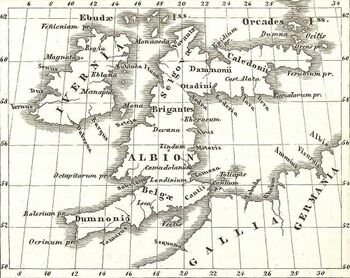
There may be some connection between the un-named prince and a semi-mythical Irish king. Túathal Techtmar ("the legitimate"), was the son of Fíachu Finnolach, and himself a High King of Ireland according to medieval Irish legend and historical tradition. He is said to be the ancestor of the Uí Néill (O'Neil) and Connachta (Connor) dynasties through his grandson "Conn of the Hundred Battles". Túathal is said to have been exiled from Ireland as a child, but to have returned, defeated the then king and waged extensive war. Both Roman sites at Drumanagh and Lambay are close to where the semi-mythical Túathal is supposed to have landed. Some other archaeological discoveries inside Ireland, including Roman jewellery and coins at Tara, the midland ritual complex, and at Clogher, further support the possibility of a Roman invasion of Ireland. It has been suggested that the distribution of Roman remains in Ireland fits well with the places associated with Túathal's campaign. The traditional date of his return is AD76-80.
Speculating somewhat, it is notable the the unique "Elliptical Building" in Chester bears some resemblance to the ritual structures at Tara, and comes from roughly the same period as the supposed invasion by Agricola and the presence of the "prince", who may (possibly) have been Túathal, in Britain. The lead pipe from the elliptic building is dated to AD 79 and Tacitus (Chapter 24) says that in AD 82 Gnaeus Julius Agricola "crossed the sea and defeated people hitherto unknown to the Romans". While he does not specify which sea they crossed (many scholars think that Tacitus refers to the Clyde or the Forth), it should be noted that after this statement, Tacitus writes only about Ireland for the remainder of the chapter, which suggests that the people he was referring to were, in fact, the Irish. There is no evidence that Túathal was actually in Chester, but it does seem to have a contender for Gnaeus Julius Agricola's "capital" and there is the remarkable co-incidence of dates:
- AD79: Elliptical building lead pipe (stamped on it);
- ~AD76-80: Túathal returns to Ireland (traditional);
- AD82: Agricola "crosses the sea" (Tacitus);
In addition Tacitus mentions that Gnaeus Julius Agricola frequently said that Ireland could be conquered with "a single legion and a few auxiliary troops", which suggests the Romans expected some special advantage if they invaded Ireland. This could have been knowledge of local troop dispositions, geography and local rivalries, but could it also have been the presence on the Roman side of a credible claimant to the Kingship of Ireland? So could the Elliptical Building have been connected to this - a palace for a potential king, with a design similar to the ritual site at Tara and a fountain that must have seemed magical at the time? A bauble to show Túathal the advantage of being a client of Rome?
Even if there was no invasion there was almost certainly trade, as the geographer Ptolemy (c. AD 90 – c. 168) writing in the second century made a map of "Hibernia" with reasonably accurate data on rivers, mountains and people, thereby demonstrating some considerable knowledge of the island had been gained by that time.
Exploring Roman Chester
The "not to be missed" elements of a visit are the Roman parts of the City Walls, the Amphitheatre (and the nearby Roman Gardens), the Minerva Shrine and the Grosvenor Museum - all of which can be visited for free. A route which takes these in can be found in the Roman Festival Trail.
Sources and Links
Related Pages
- City Walls: a guide to the city walls, including both the Roman parts (much reconstructed) and the extension by the Anglo-Saxons (entry is free);
- Legio II: what is known about the history of the second legion, including their time in Chester;
- Legio XX: what is known about the history of the tenth legion, including their time in Chester;
- Grosvenor Museum: contains the largest collection of Roman tombstones in Britain, some of which are military (entry is free). Has a small shop, with some books;
- Amphitheatre: a guide and history about the remains of the amphitheatre in Chester (entry is free)
- Minerva Shrine:
- Roman Ireland;
- List of Roman finds (defences)
- Roman Festival Trail;
- Saxon: what came next;
Online
- Watkin's "Roman Cheshire": free e-book
- Roman Britain on Chester;
- Discover Chester on Roman Chester
- a Russian website on Roman Chester;
- A site on Roman Cheshire by K Matthews;
- The excellent Vici.org;
Chester in Other Historical Periods
- Before The Romans;
- Roman Chester;
- Dark Ages;
- Medieval Chester;
- Tudor Chester;
- Stuart Chester and Civil War;
- Georgian Chester;
- Victorian Chester;
further sources
<1> Monograph: Mason, D. J. P.. 2005. Exacavations at Chester: The Roman fortress baths, excavations and recording 1732-1998. Survey Report No 13.
<2> Book: Horsley J. 1732. Britannia Romana.
<3> Book: Thompson Watkin W. T.. 1886. Roman Cheshire: A Description of Roman Remains in the County of Chester.
<4> Book: Harris, B.E. (ed). 1987. A History of the County of Chester: Volume I: Physique, Prehistory, Roman, Anglo-Saxon, and Domesday (Victoria County History).
<5> Article in Journal: Brushfield, T N. 1885. The Roman remains of Chester: With particular description of those discovered in Bridge Street. Old Series Journal of the Chester Archaeological and Historic Society. Volume 3.
<6> Article in Journal: Hubner, Prof.. 1890. The Roman Inscriptions of Deva (Chester). Journal of the Chester Archaeological and Historic Society. Volume 3.
<7> Article in Journal: Hewitt, John. 1895. The Rows of Chester, an Attempt to Discover their Origin. Journal of the Chester Archaeological and Historic Society. Volume 5.
<8> Article in Journal: Haverfield, F. 1900. Catalogue of the Roman Sculptured stones in the Grosvenor Museum. Journal of the Chester Archaeological and Historic Society. Volume 7. No 189.
<9> Article in Journal: Brushfield, T N. 1895. The Rows of Chester. Journal of the Chester Archaeological and Historic Society. Volume 5.
<10> Article in Journal: Newstead, Robert (Prof.). 1926. Records of Archaeological Finds at Chester. Journal of the Chester Archaeological and Historic Society. Volume 27, Part 2.
<11> Article in Journal: Lawson, P H. 1926. Schedule of the Roman Remains of Chester with Maps and Plans. Journal of the Chester Archaeological and Historic Society. Volume 27, Part 1. No 37.
<12> Article in Journal: Anon. 1909. Miscellanea. Journal of the Chester Archaeological and Historic Society. Volume 16: 2.
<13> Monograph: Wright, R. P. & Richmond, I. A.. 1955. Catalogue of Roman Inscribed & Sculptured Stones in the Grosvenor Museum.
<14> Book: Shrubsole, George W. 1886. Catalogue of the Roman Altars.
<15> Article in Journal: n/a. 1956. Miscellanea. Journal of the Chester Archaeological and Historic Society. Volume 43.
<16> Article in Journal: Anon. 1910. Miscellanea. Journal of the Chester Archaeological and Historic Society. Volume 17.
<17> Article in Journal: Petch A.J. 1978. Introduction. Chester Conference Nov 1977: New Evidence for Roman Chester.
<18> Article in Journal: Anon. 1964. Abstract of Proceedings. Journal of the Chester Archaeological and Historic Society. 51.
<19> Article in Journal: multiple authors. 1984/85. Excavation Reports and Sites Observed. Cheshire Archaeological Bulletin. No 10.
<20> Newsletter: Chester Archaeology. 2001. Dig News. September 2001.
<21> Newsletter: Chester Archaeology. 2002. Dig News. February 2002.
<22> Newsletter: Chester Archaeology. 2002. Dig News. April 2002.
<23> Newsletter: Chester Archaeology. 2003. Dig News. April 2003.
<24> Newsletter: Chester City Council Archaeology Service. 2002. The Past Uncovered. June 2002.
<25> Article in Journal: Peter Carrington. 1995. Among the Crumbling Ruins. British Archaeology.
<26> Newsletter: Chester City Council Archaeology Service. 2009. The Past Uncovered. February 2009.
<27> Newsletter: Chester City Council Archaeology Service. 2002. Annual Review. 2001-2002.
<28> Client Report: Chester Archaeology. 1998. 29 Bridge Street, Chester: Watching Brief. R2258. S0194. N/A. R2258.
<29> Client Report: Chester Archaeology. 1996. 25-29 Bridge Street, Chester; trial excavation.. R2689. N/A. N/A. R2689.
<30> Client Report: Gifford and Partners. 2002. Debenhams, Chester: Post-excavation Assessment Report. R3162. N/A. N/A. R3162.
<31> Book: Mason, D. J. P.. 2001. Roman Chester: City of the Eagles. p155.
